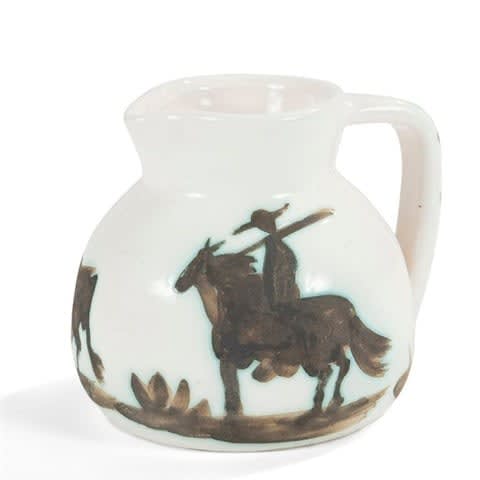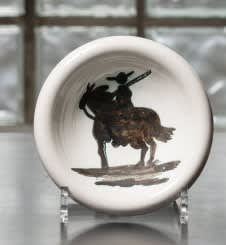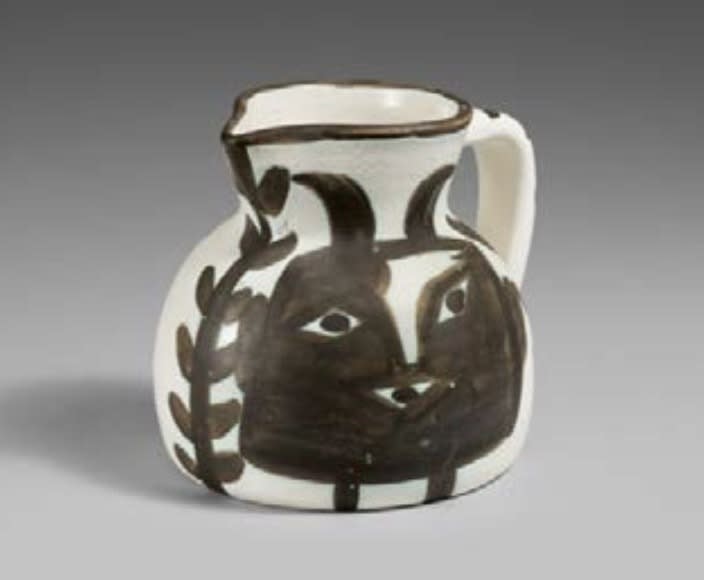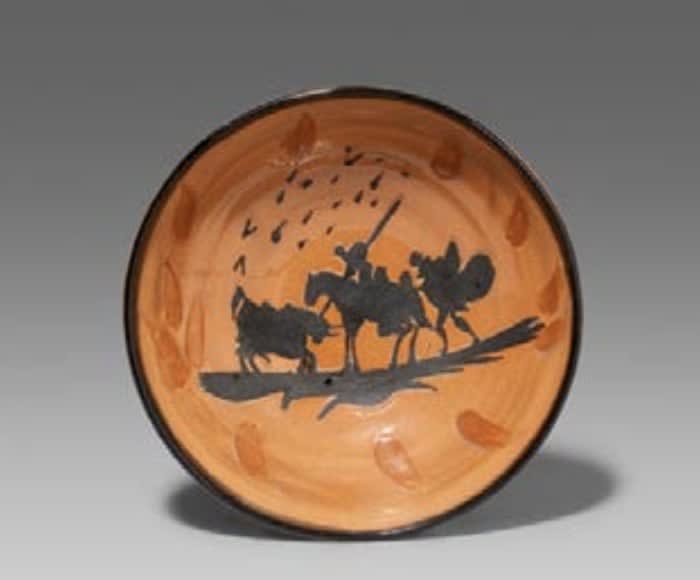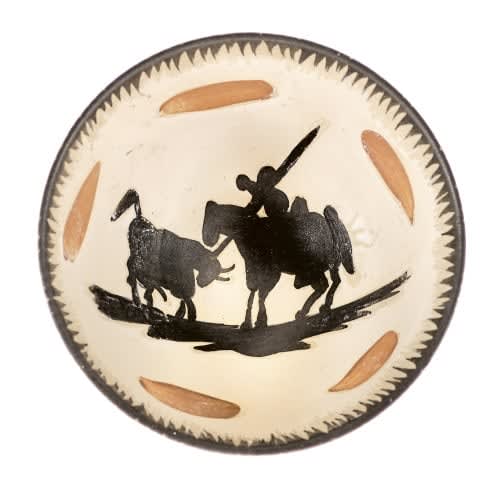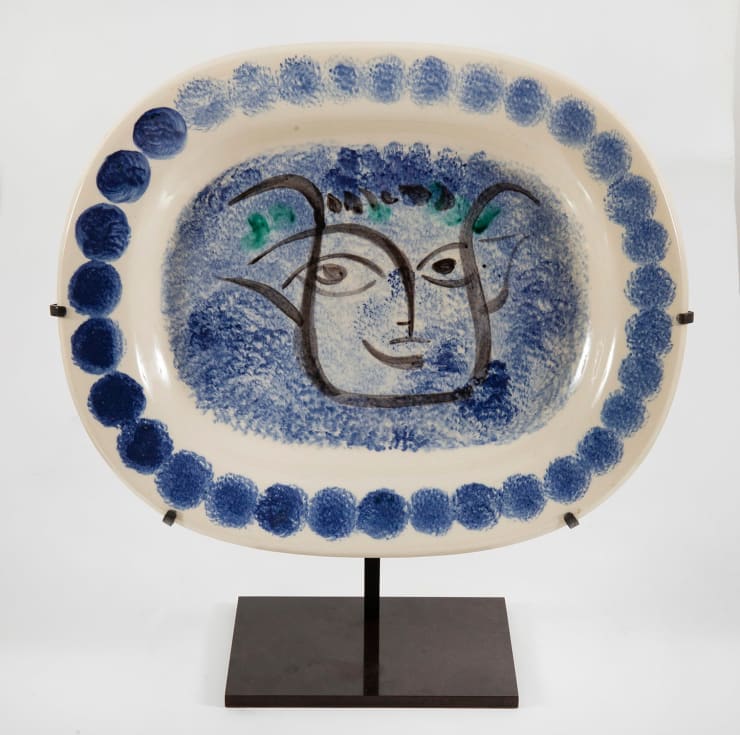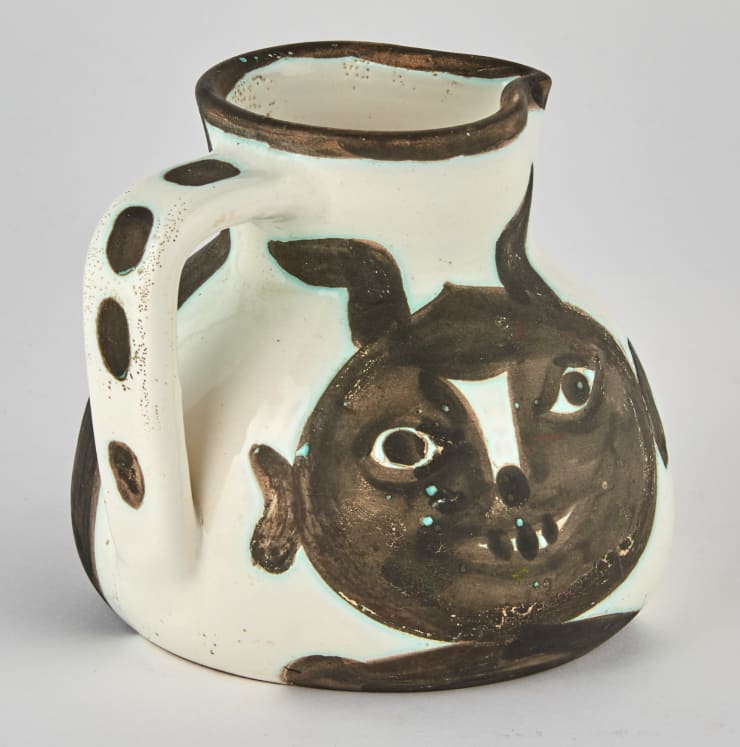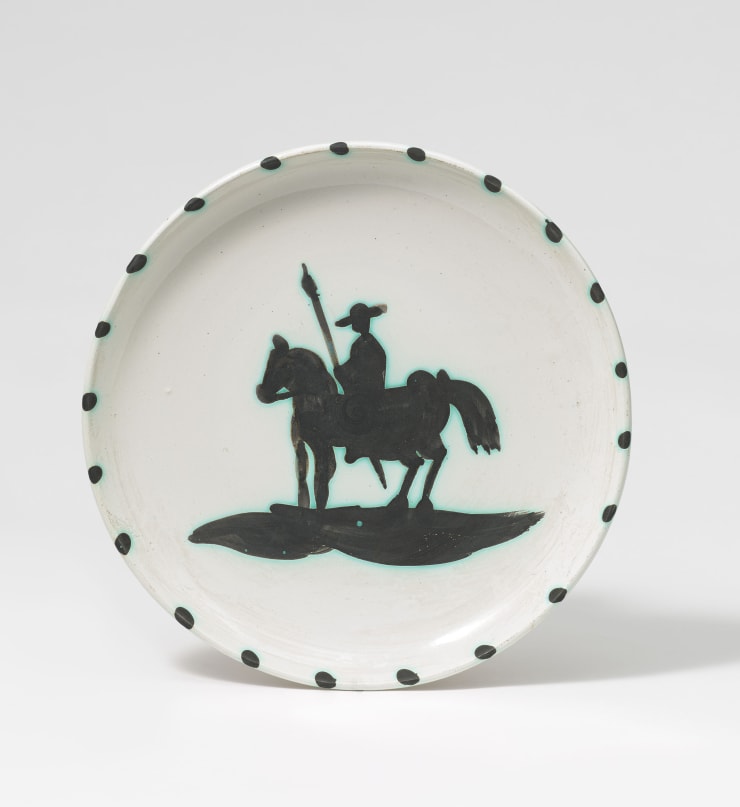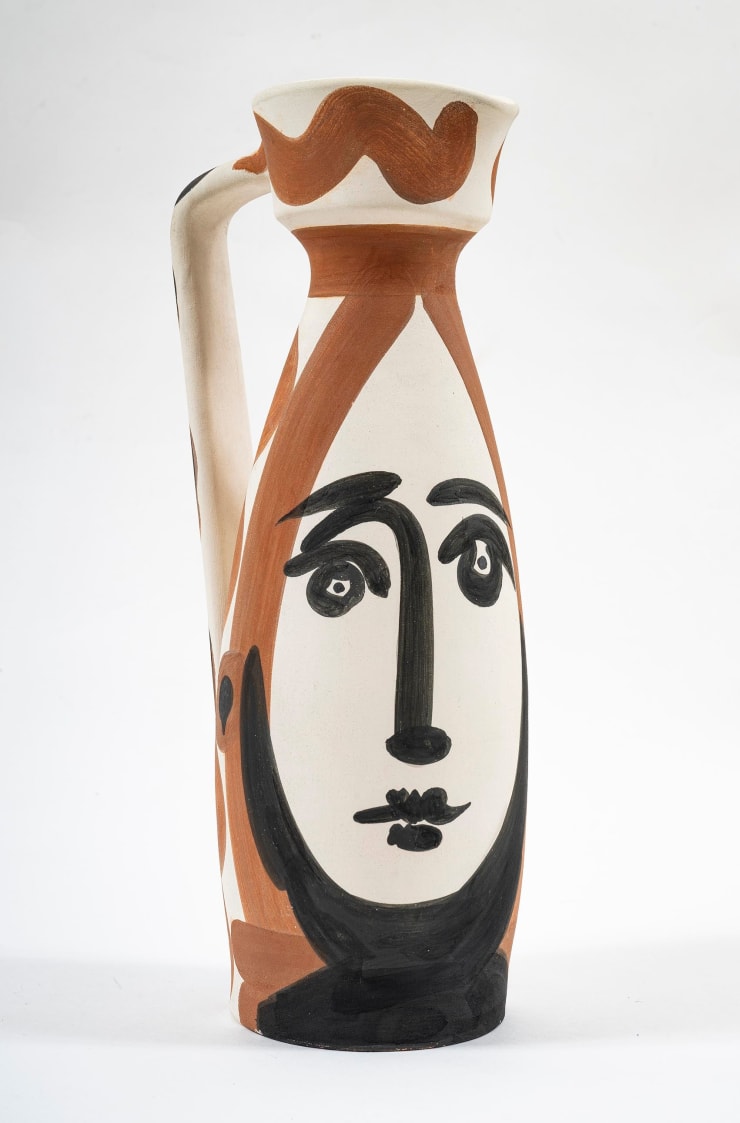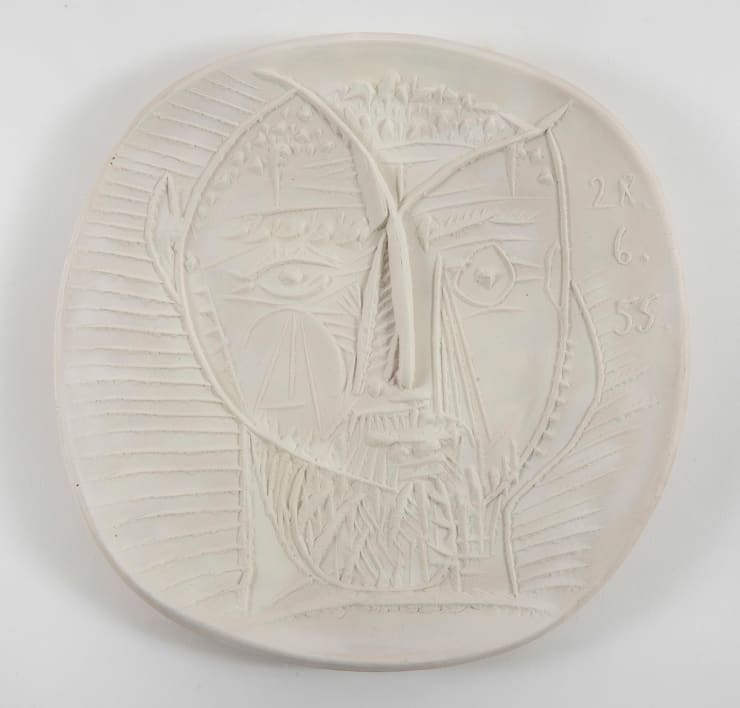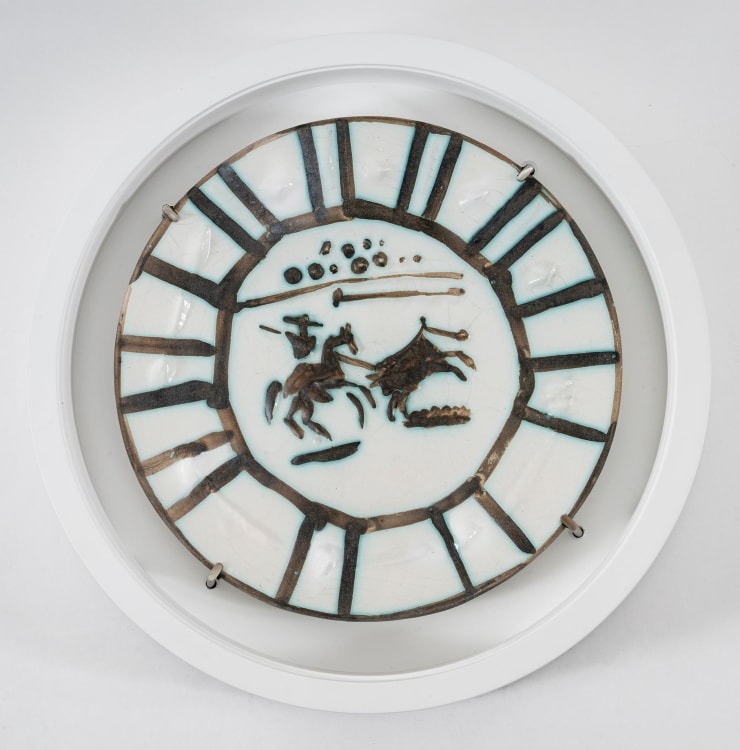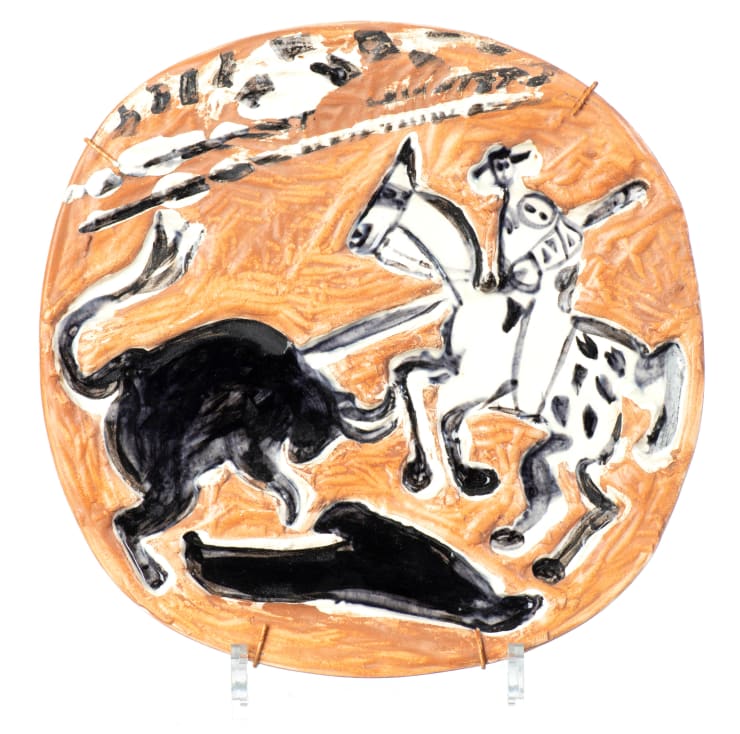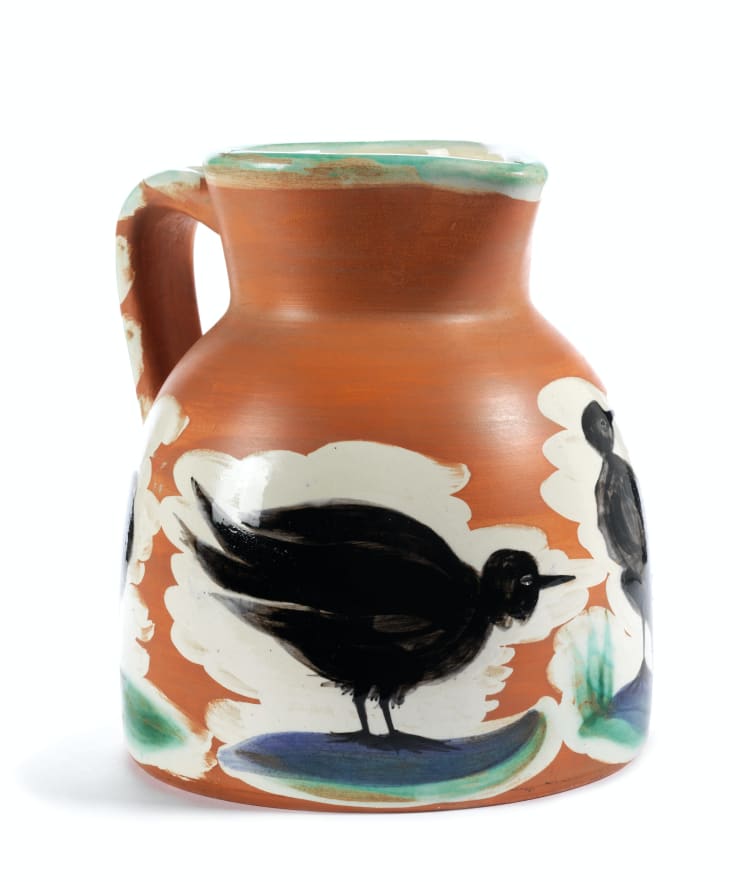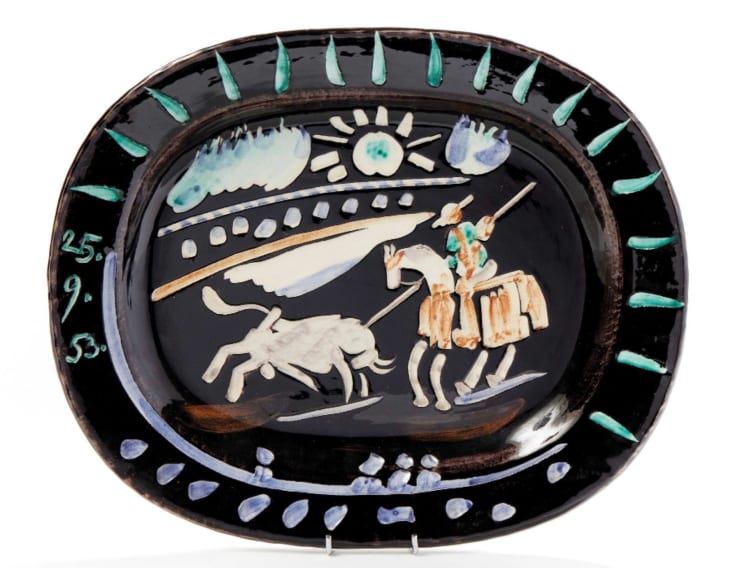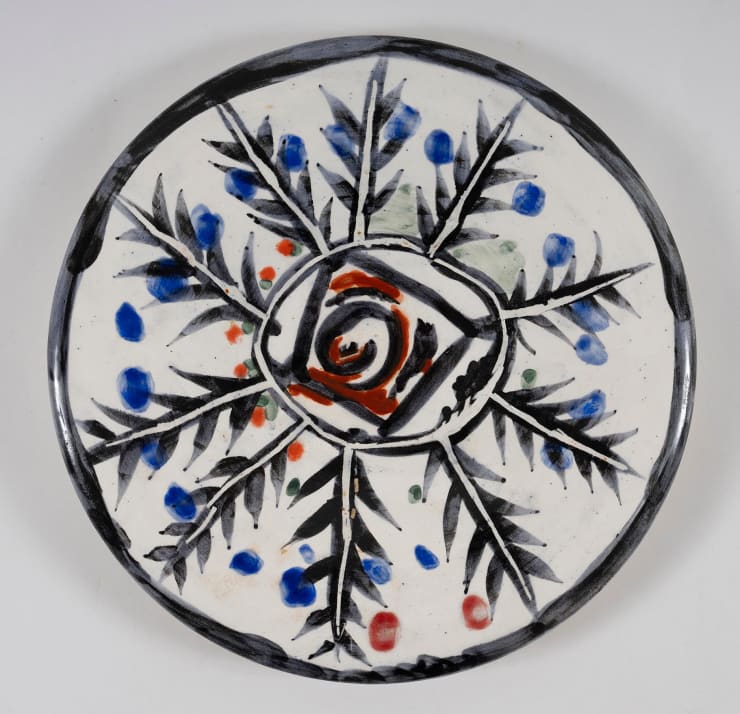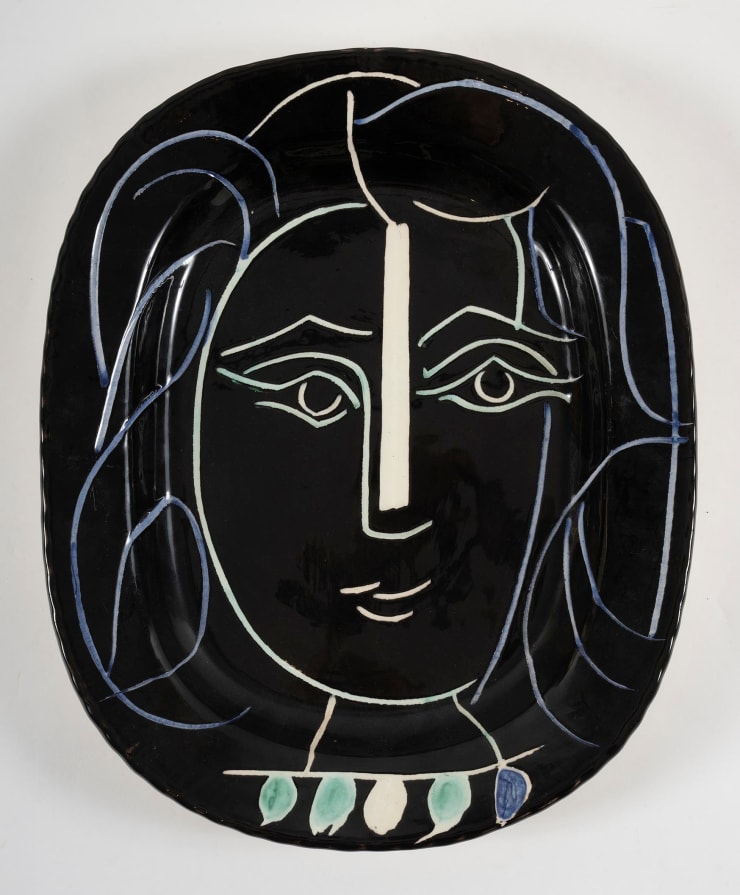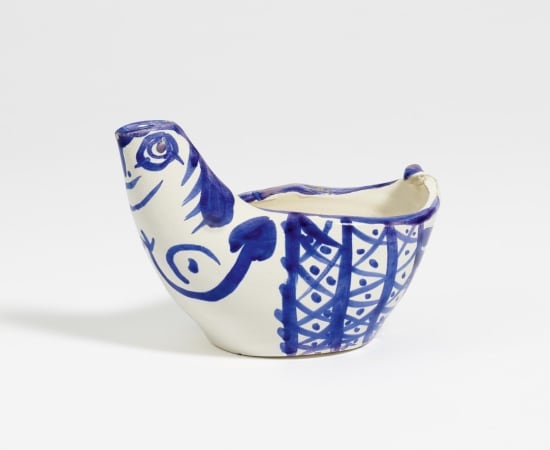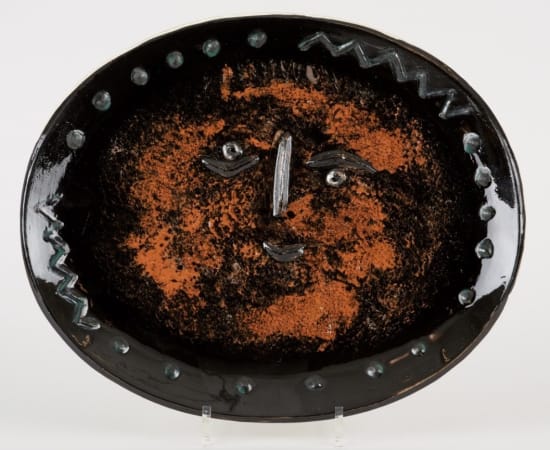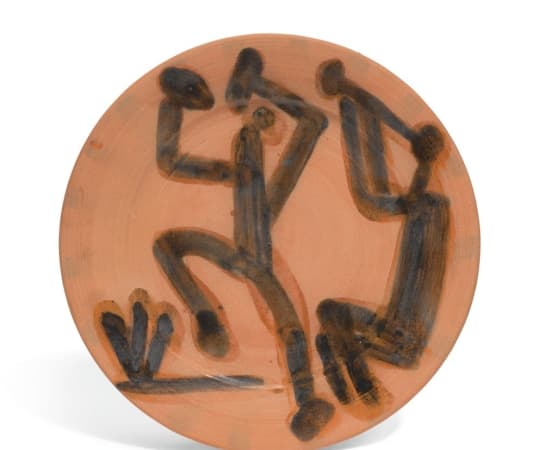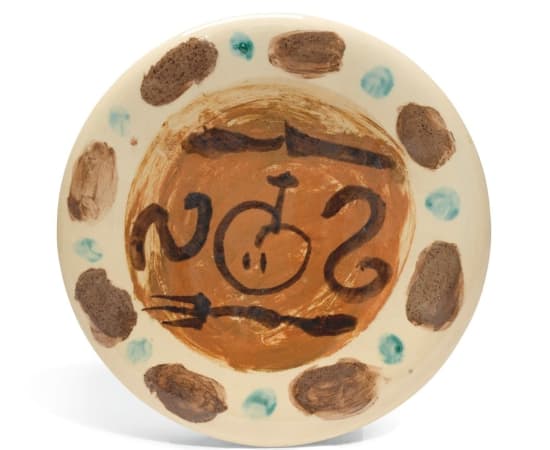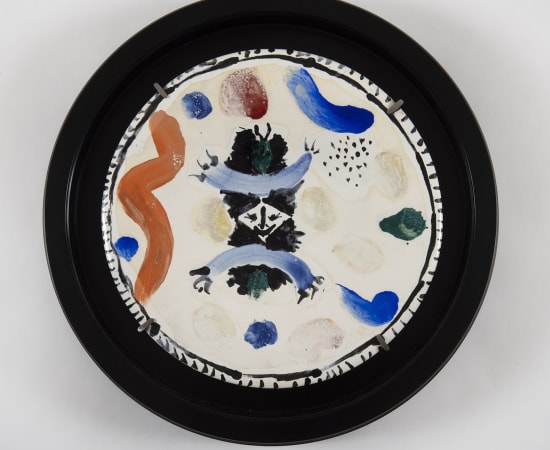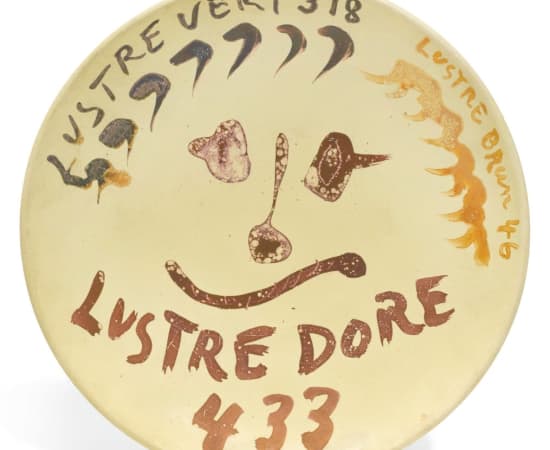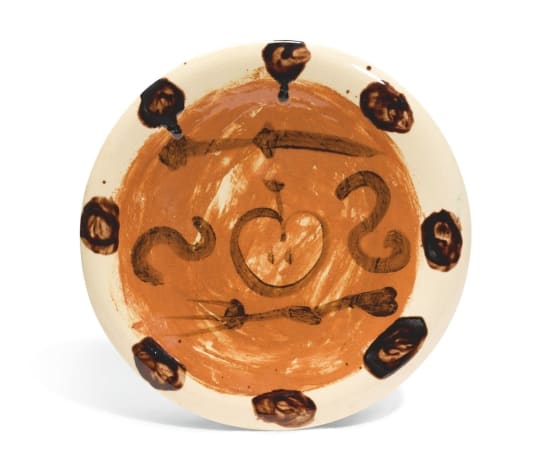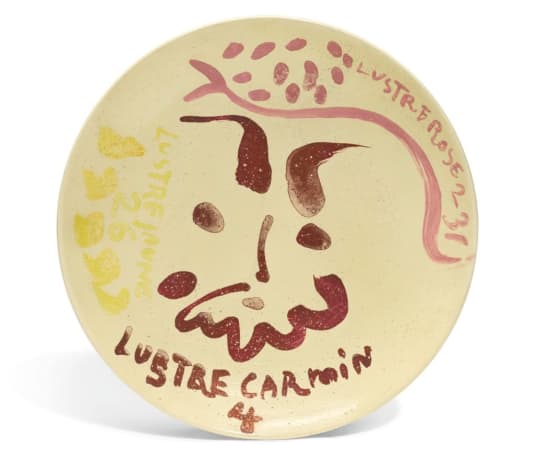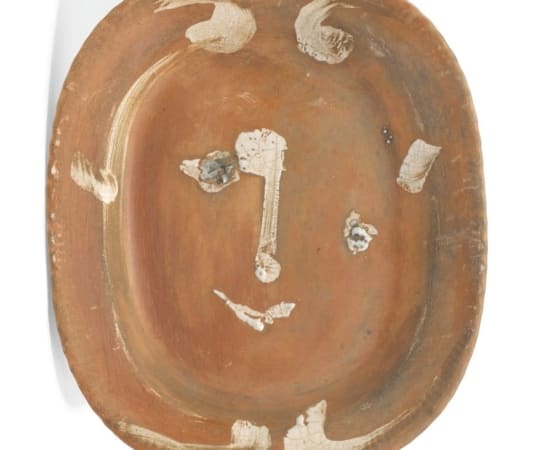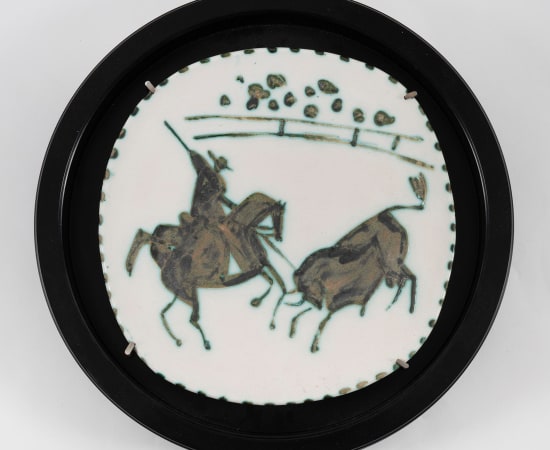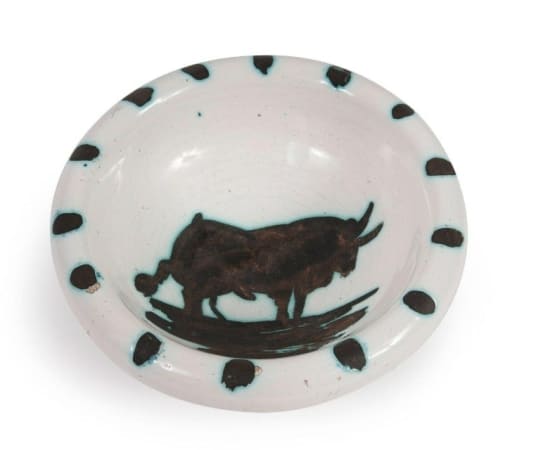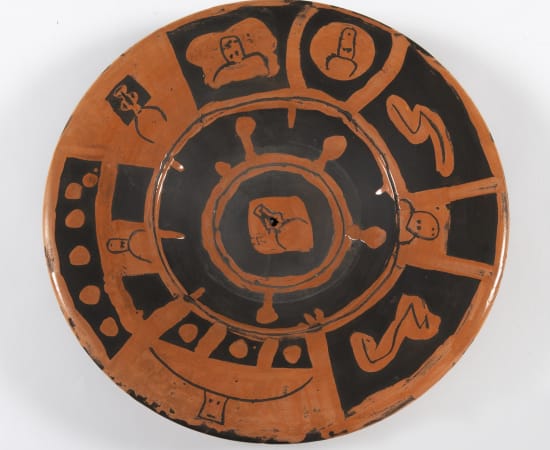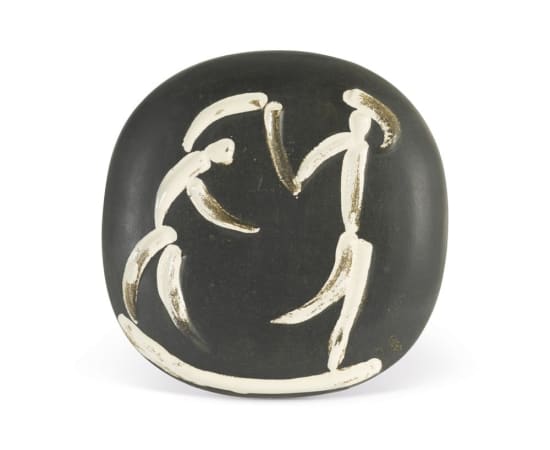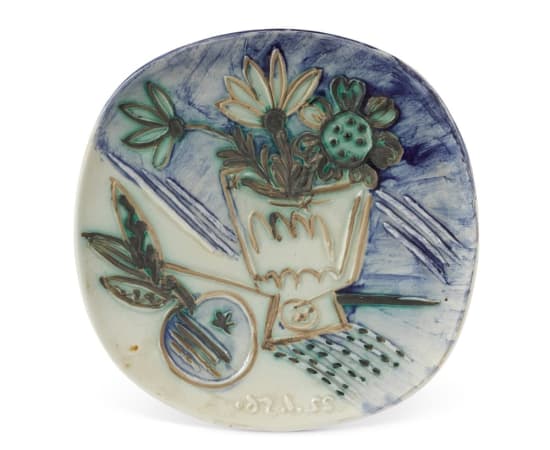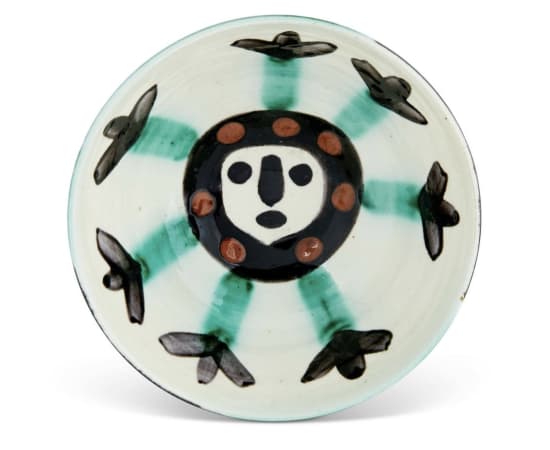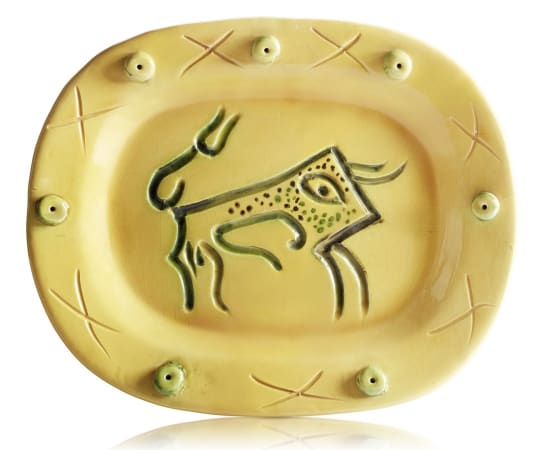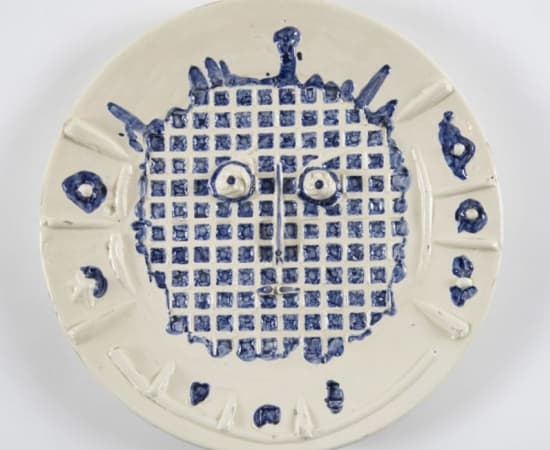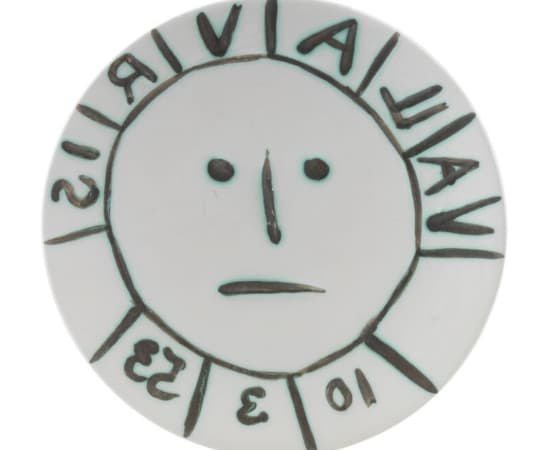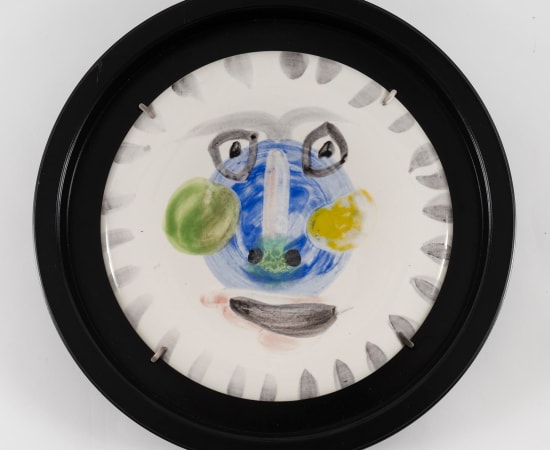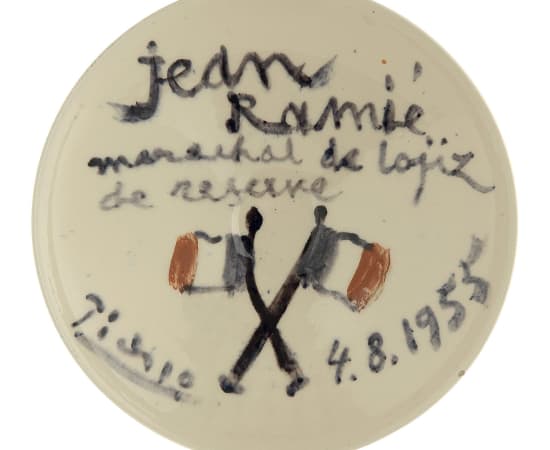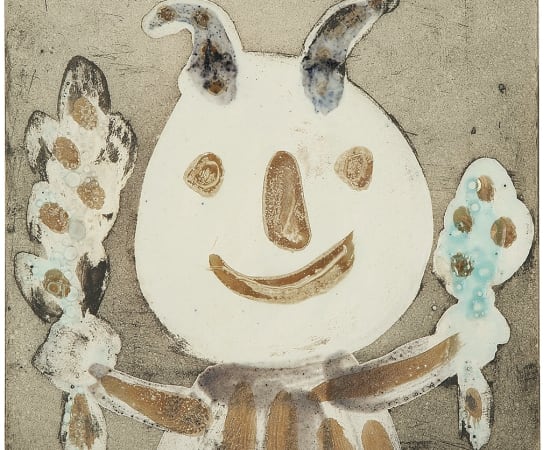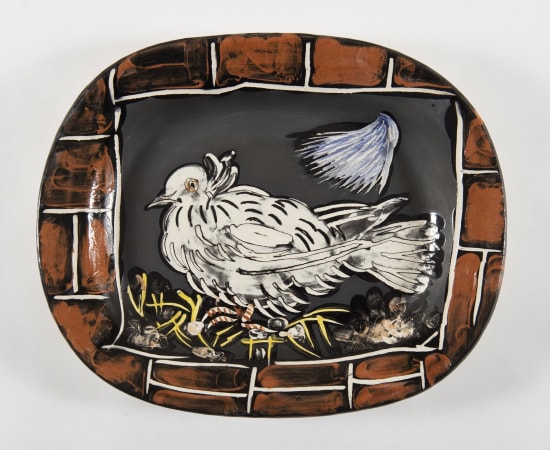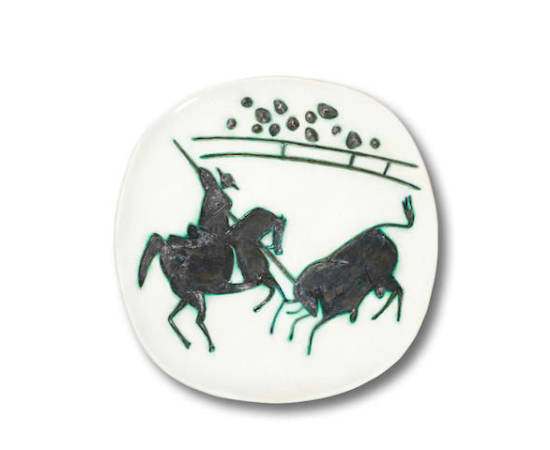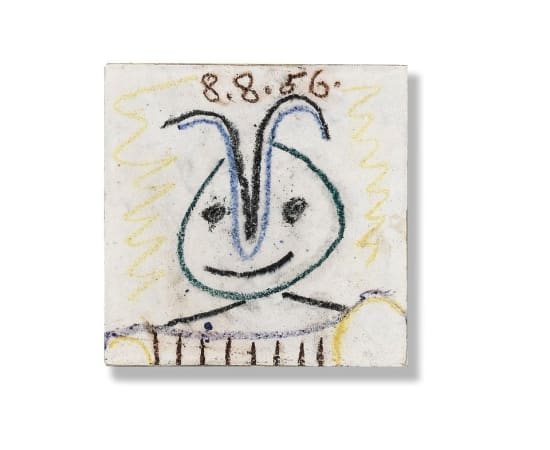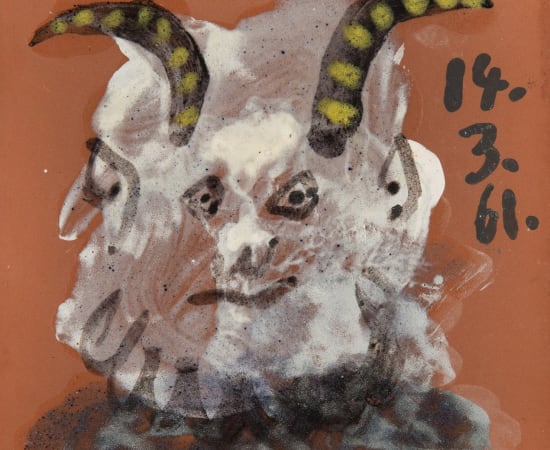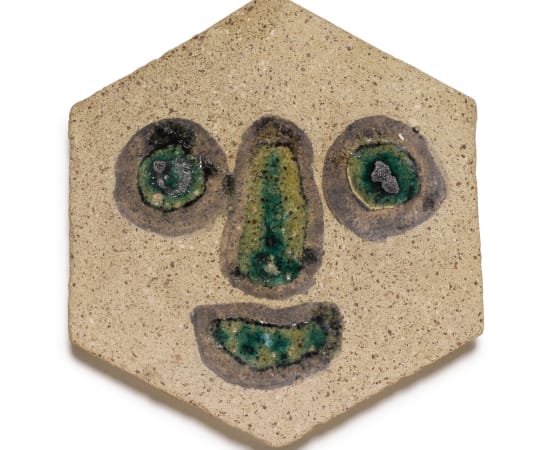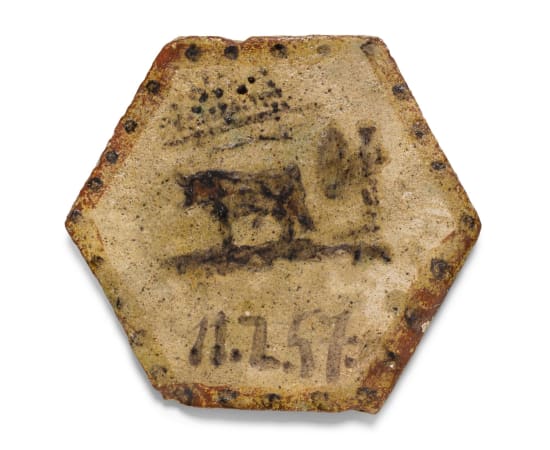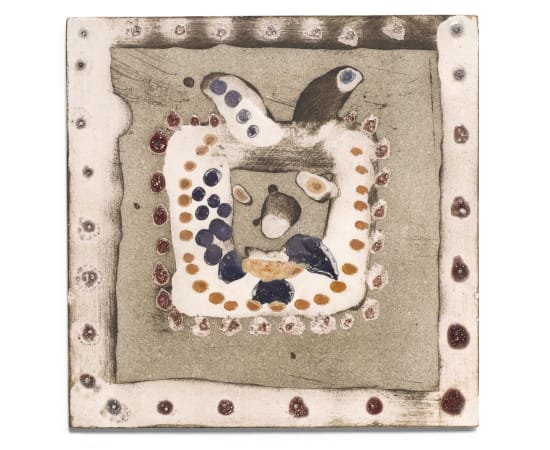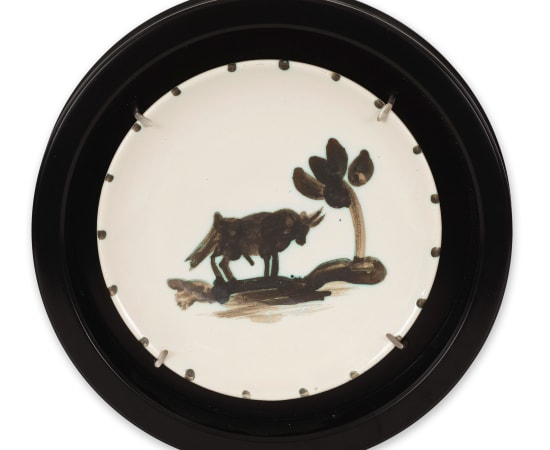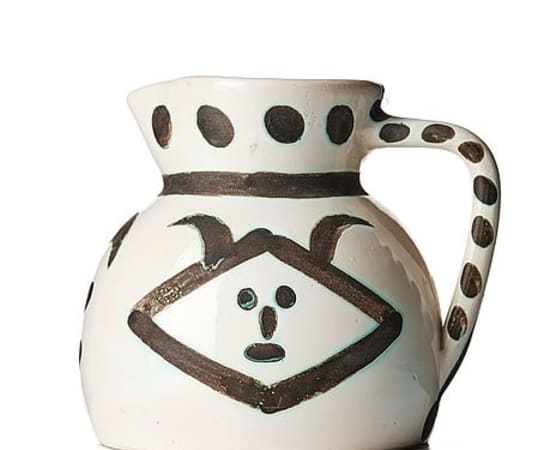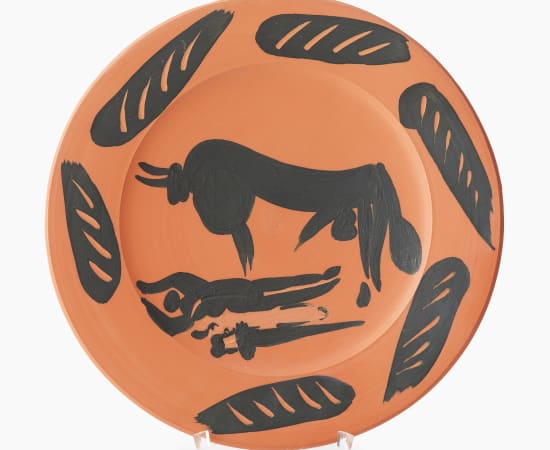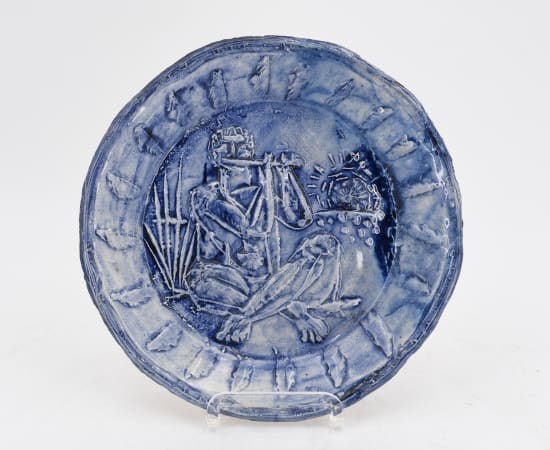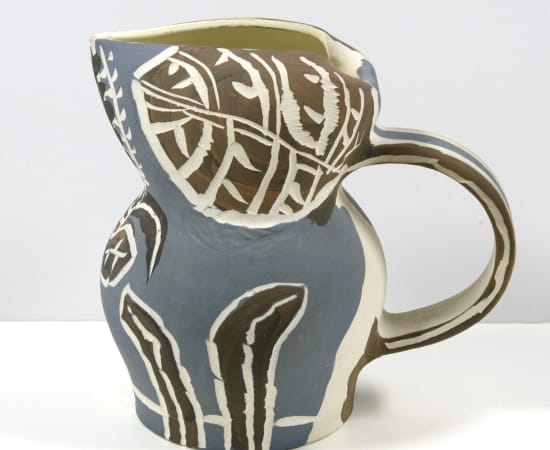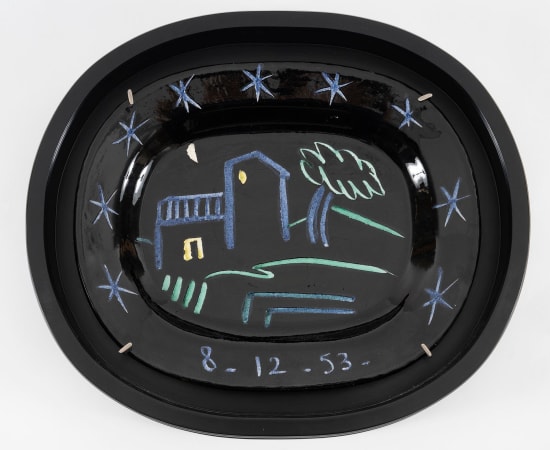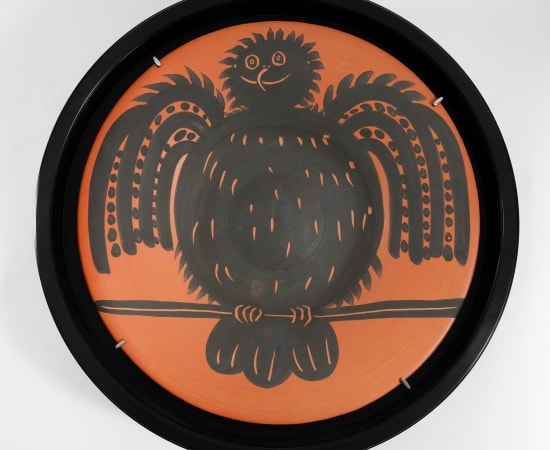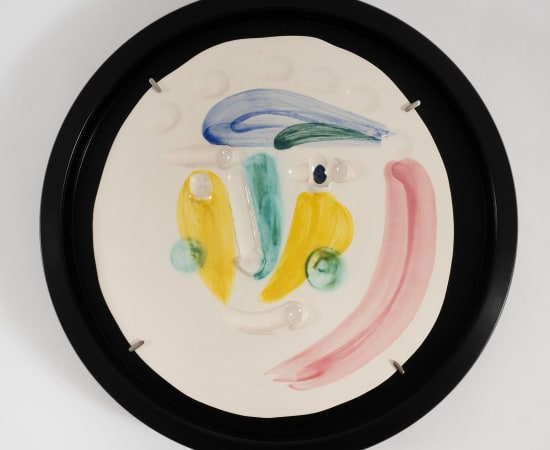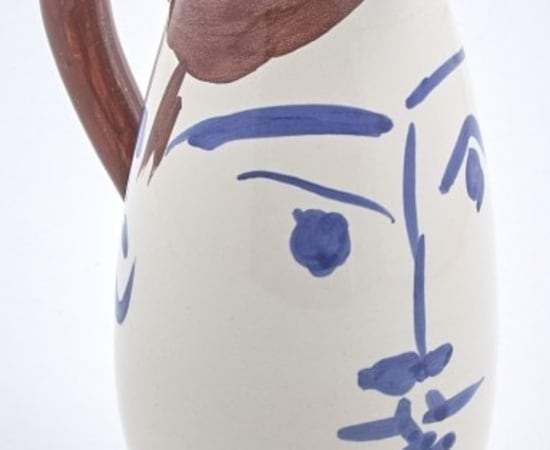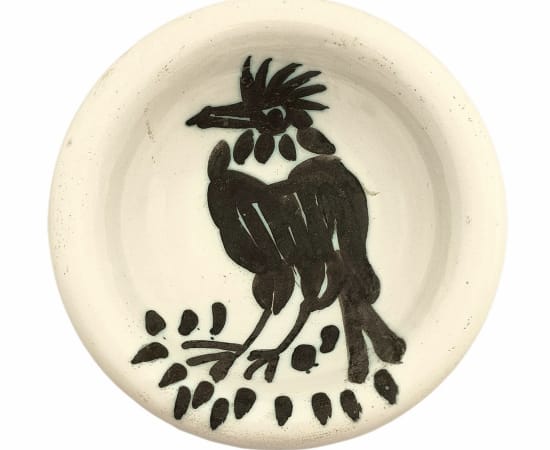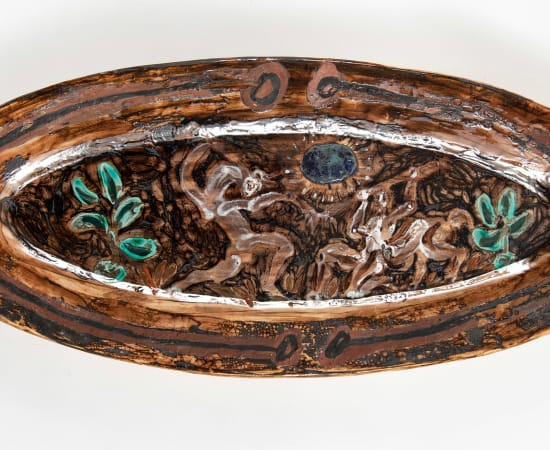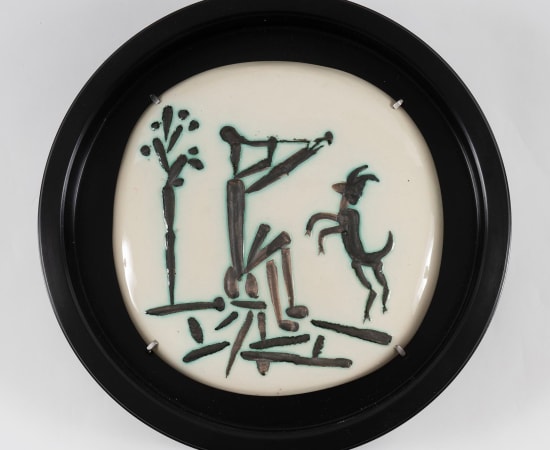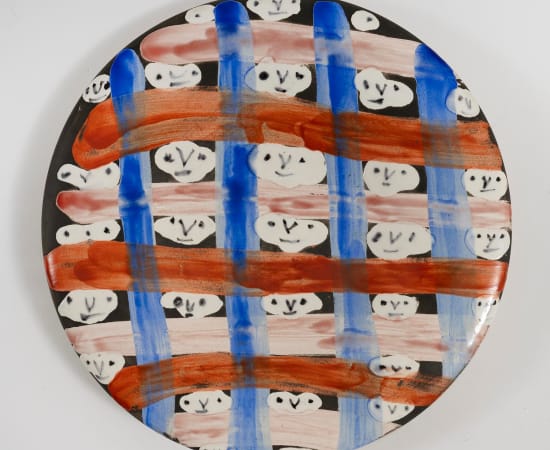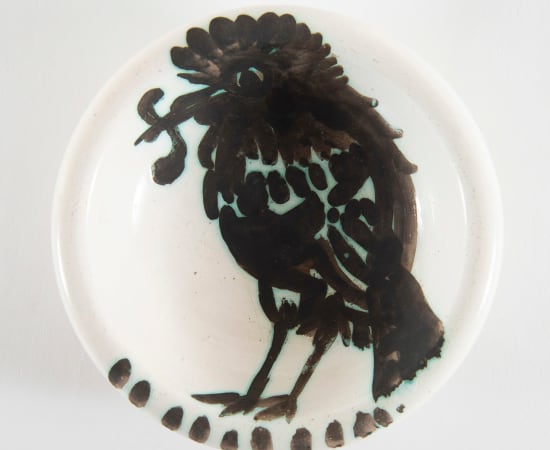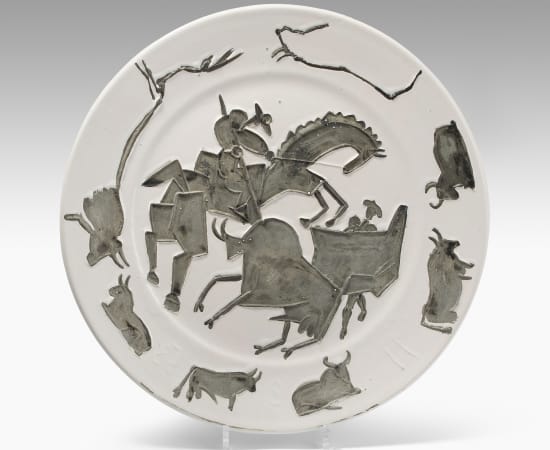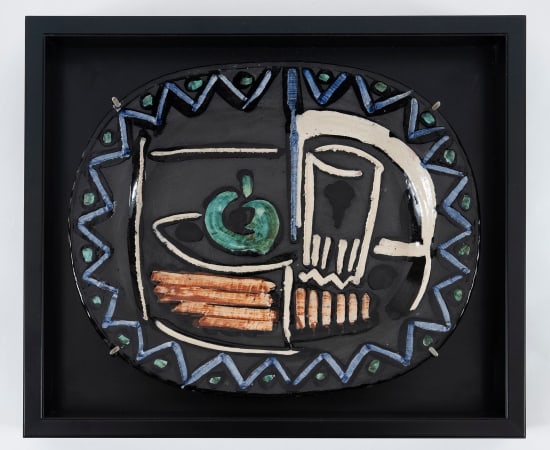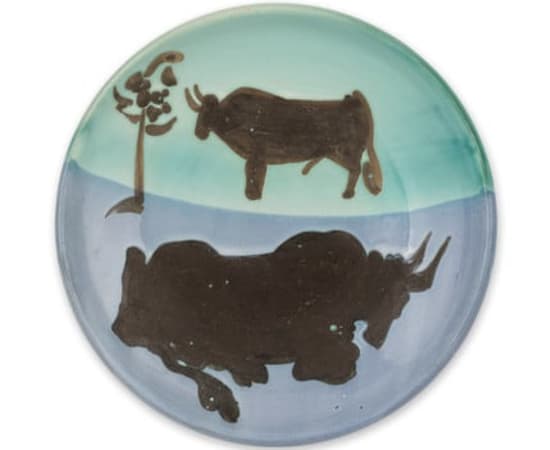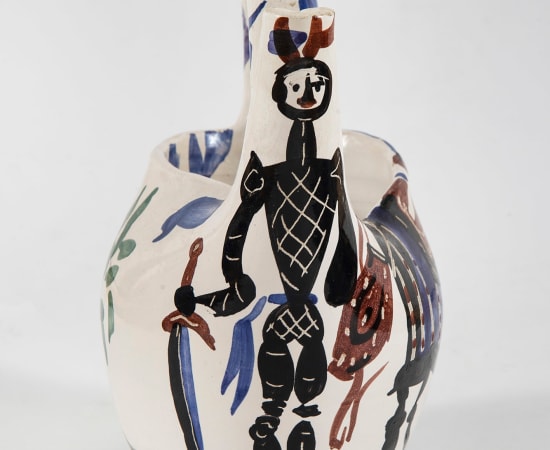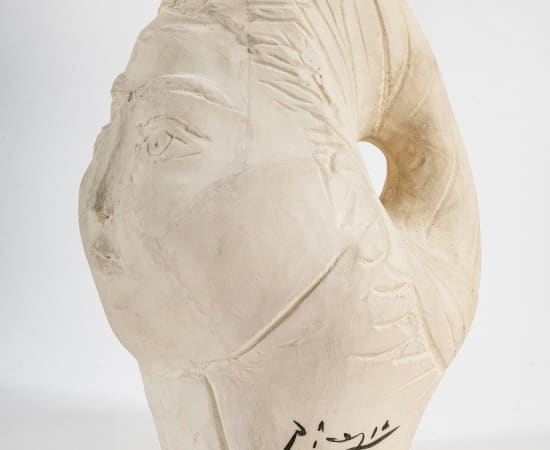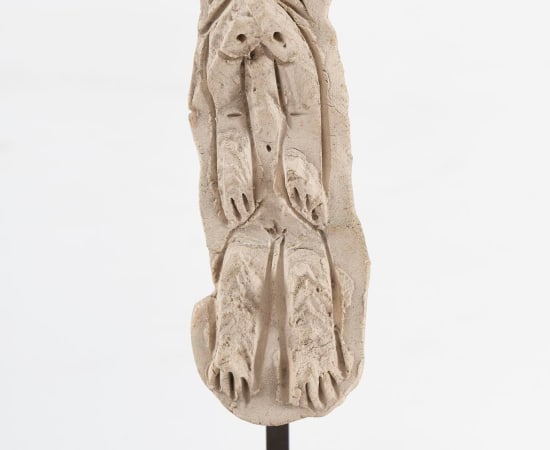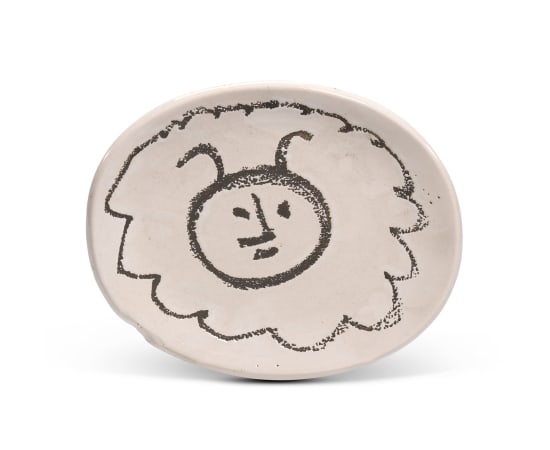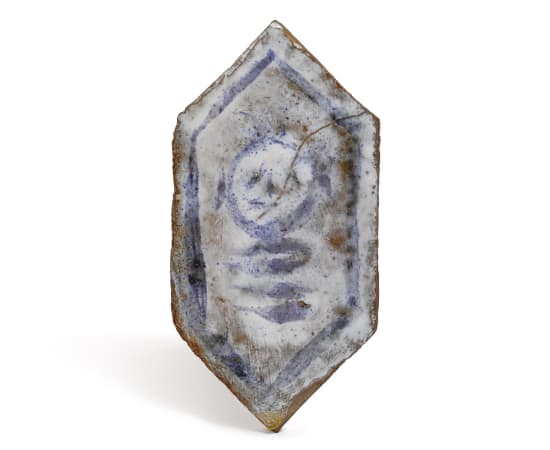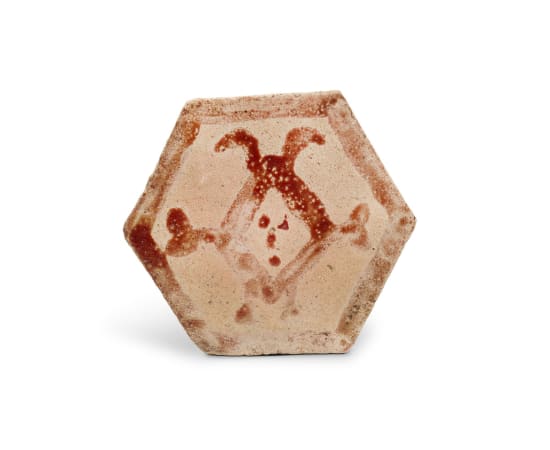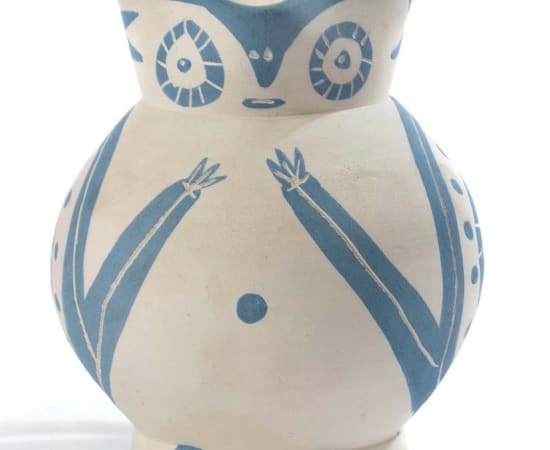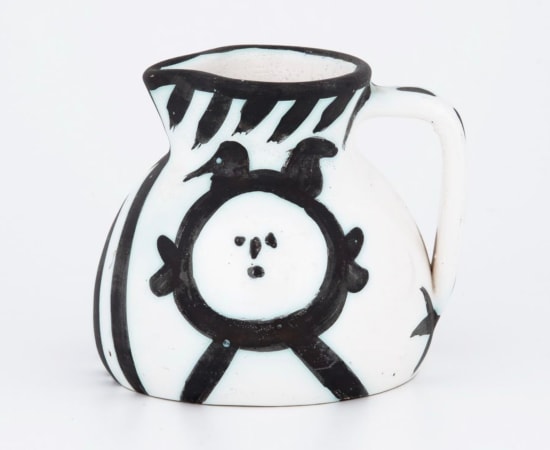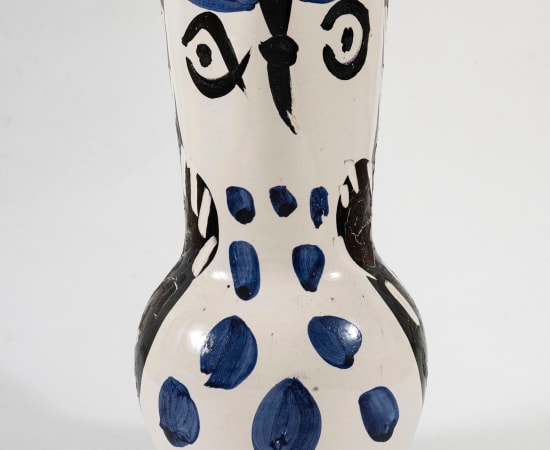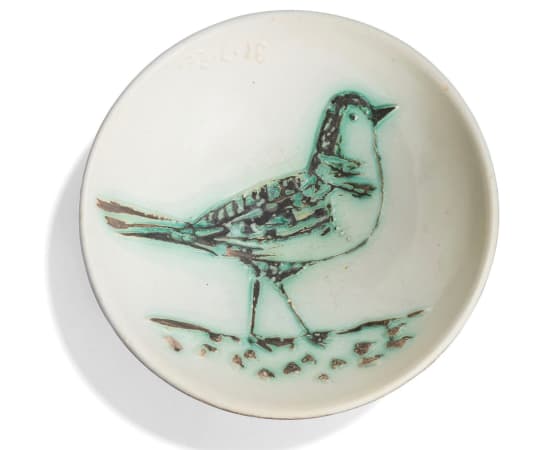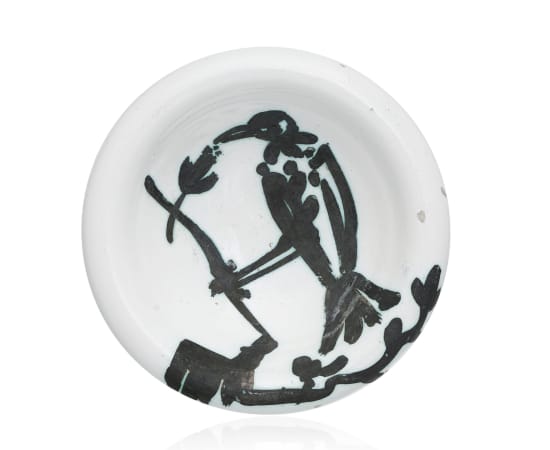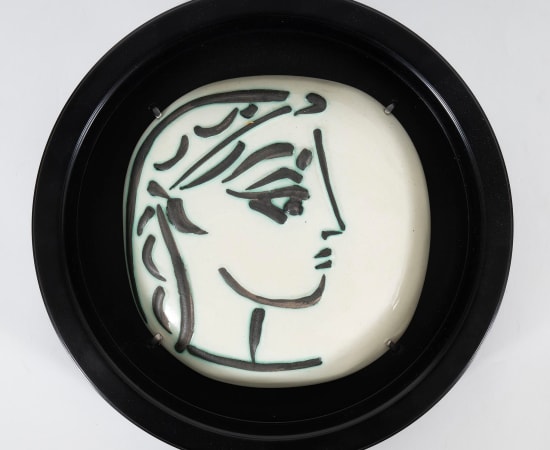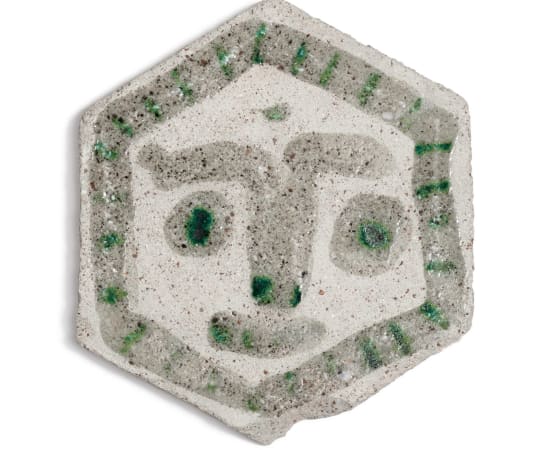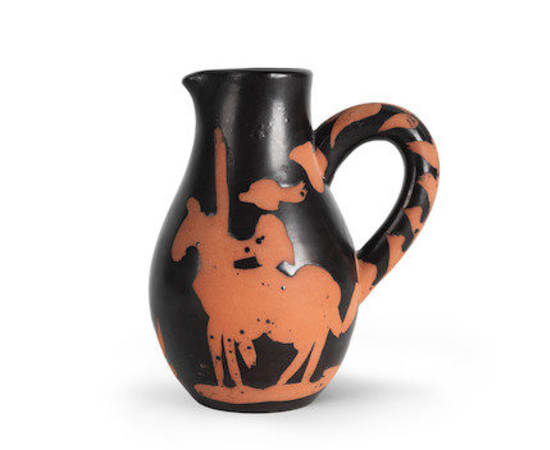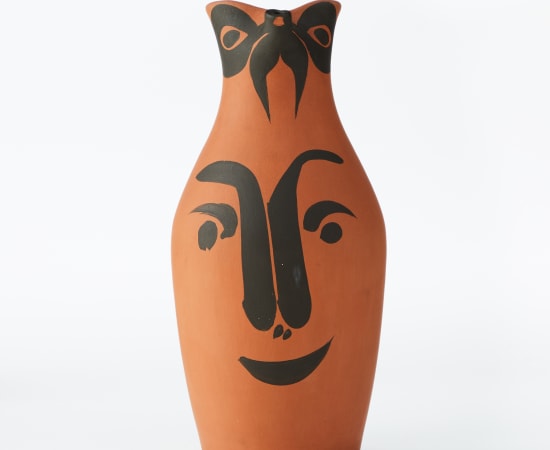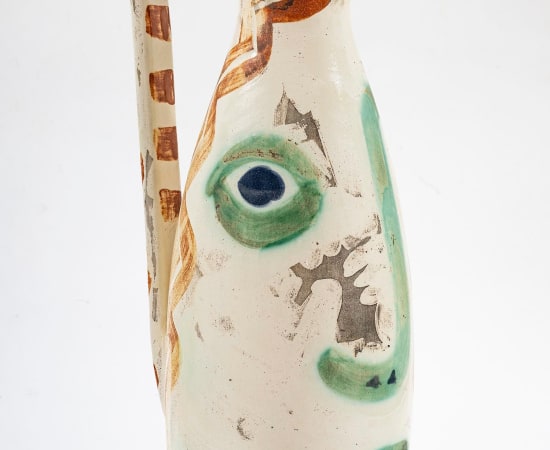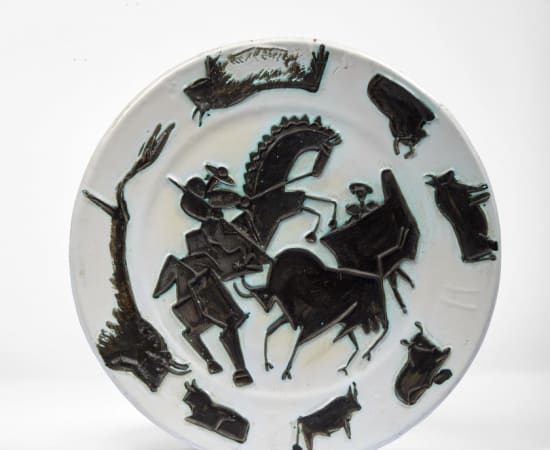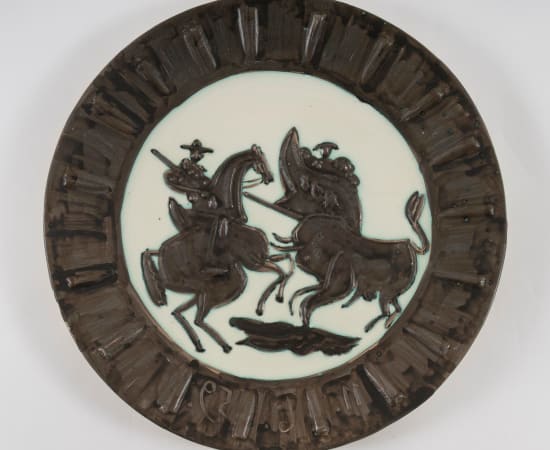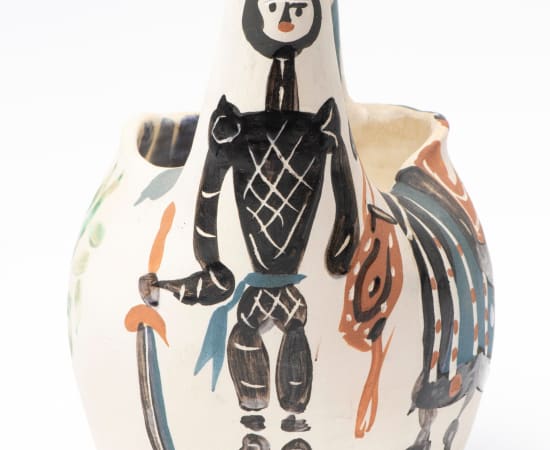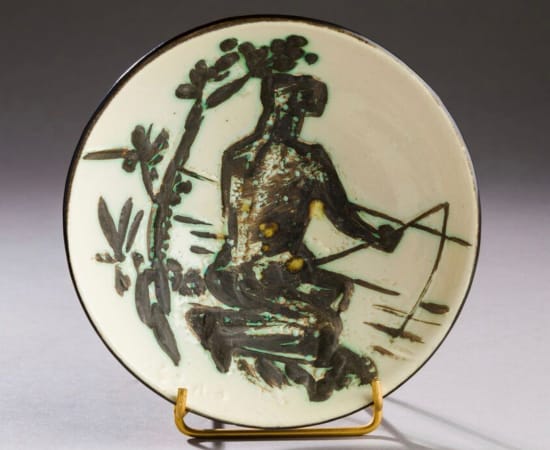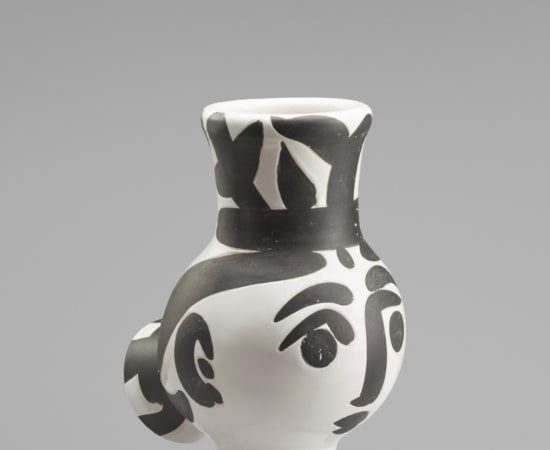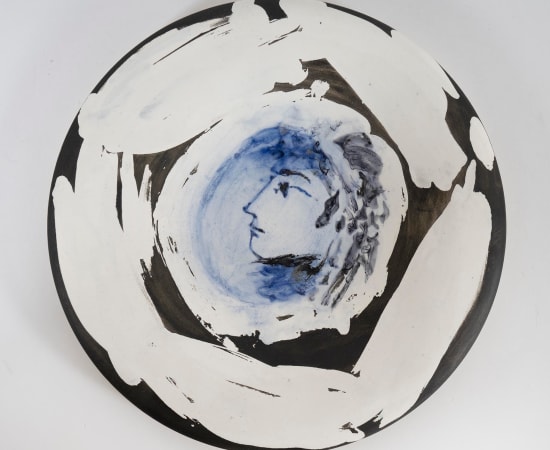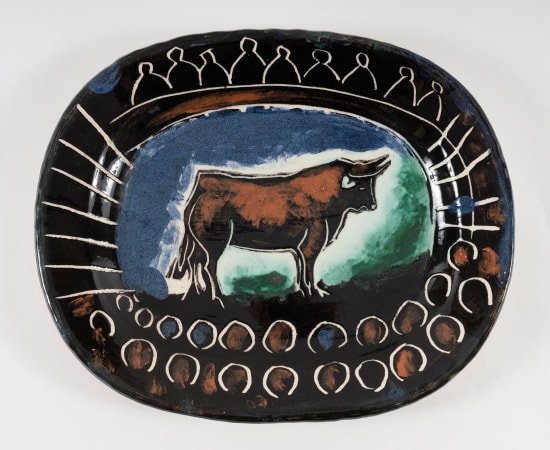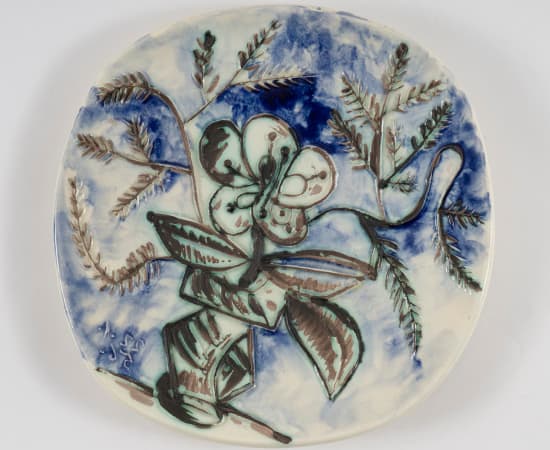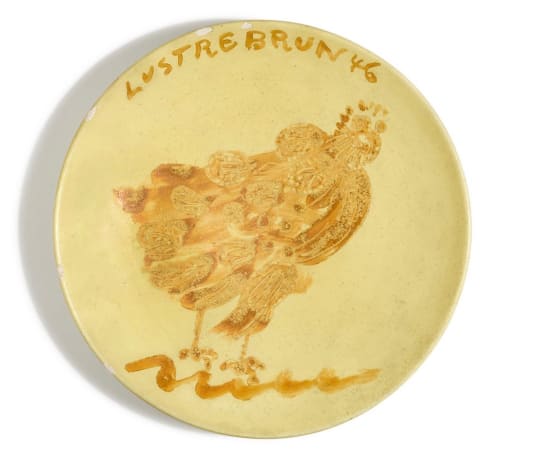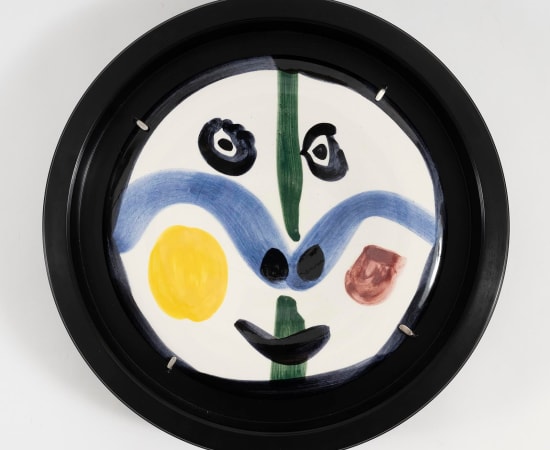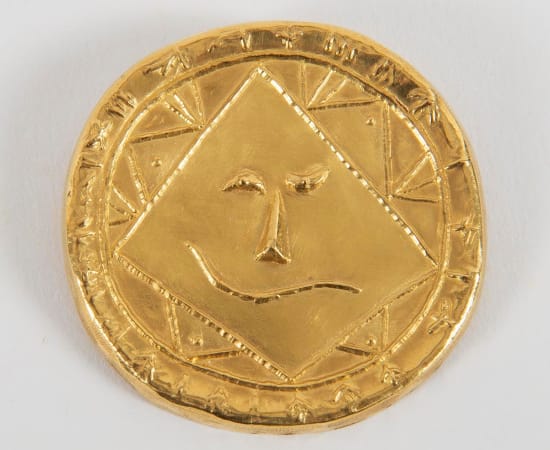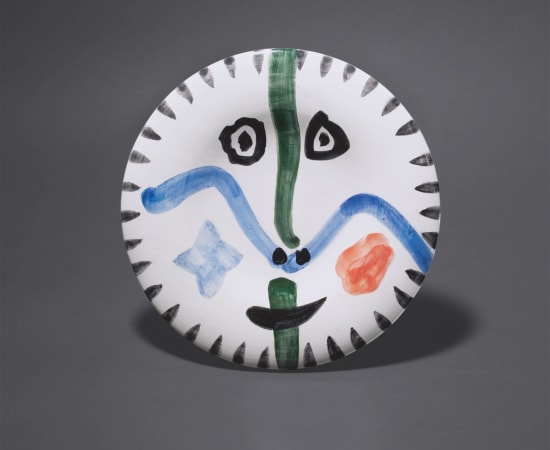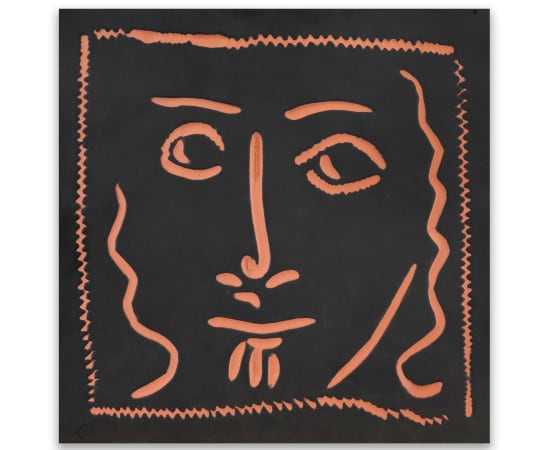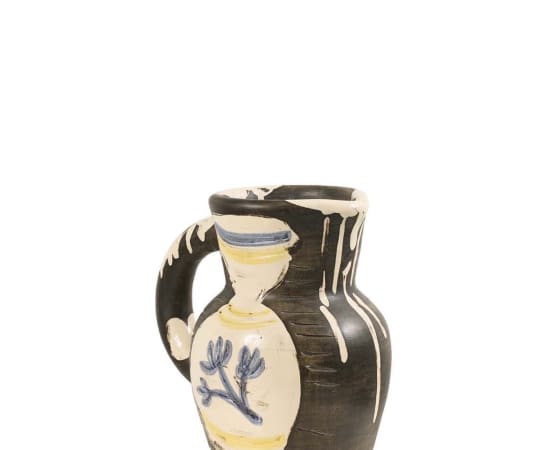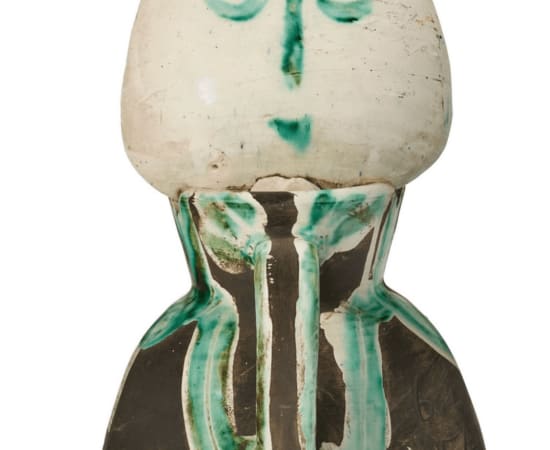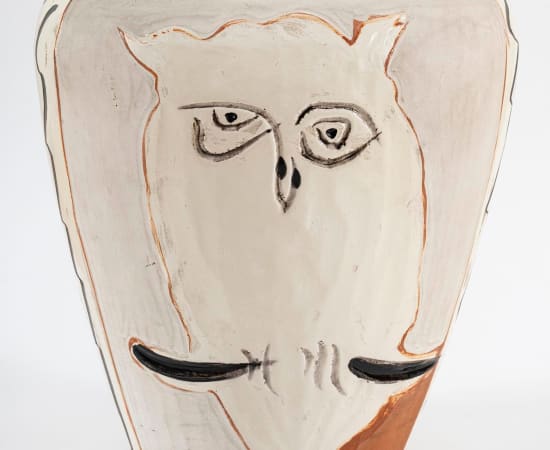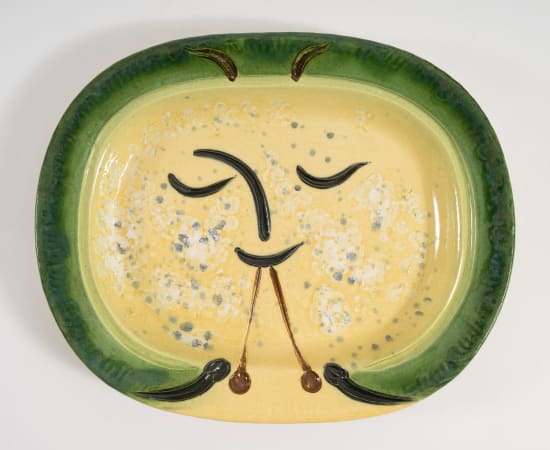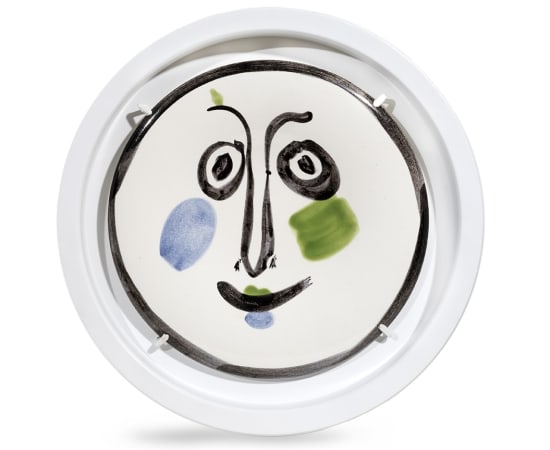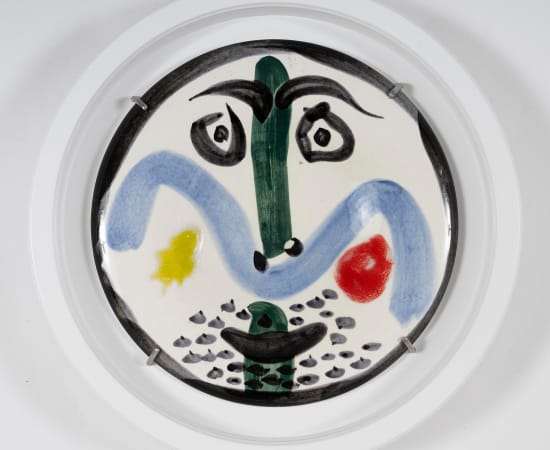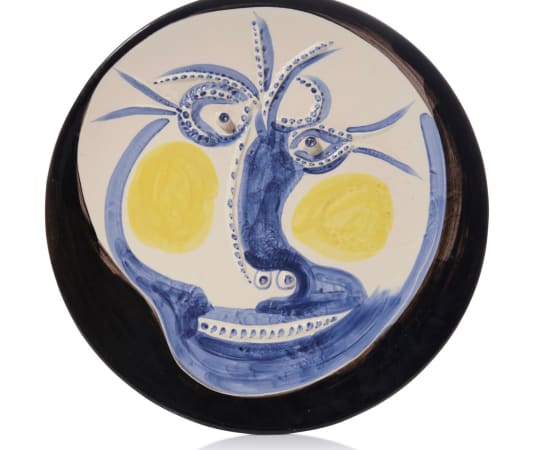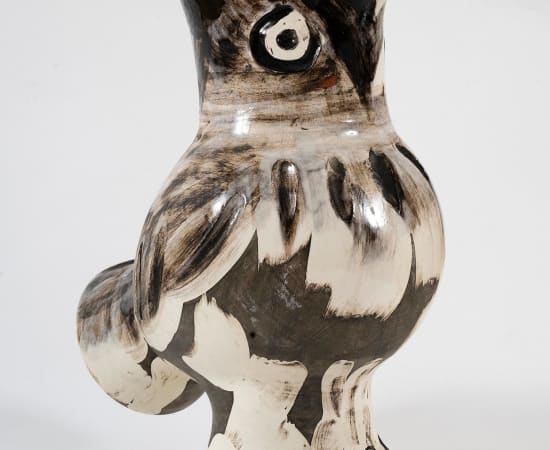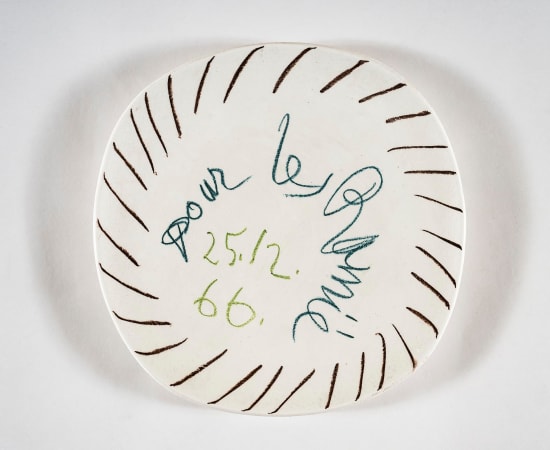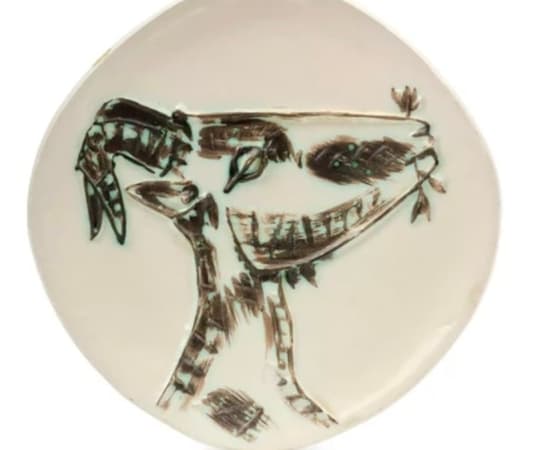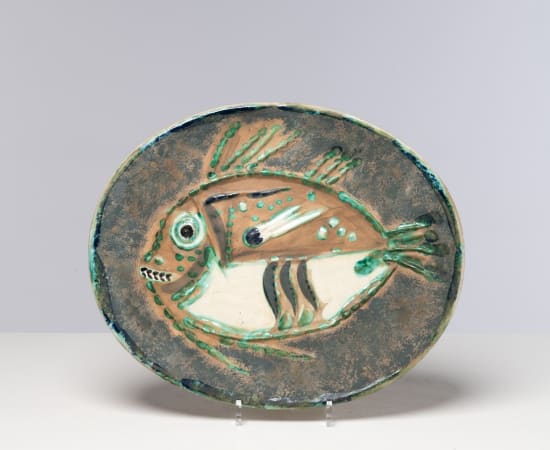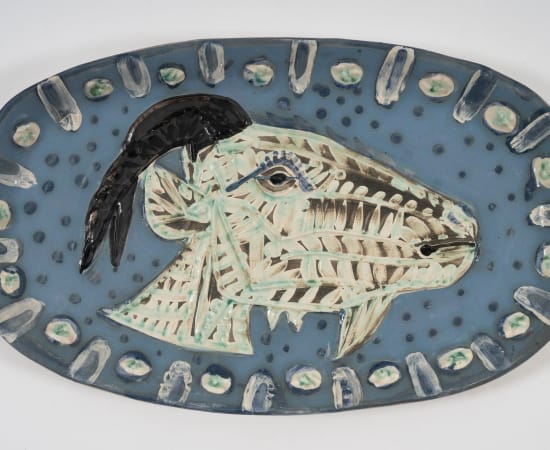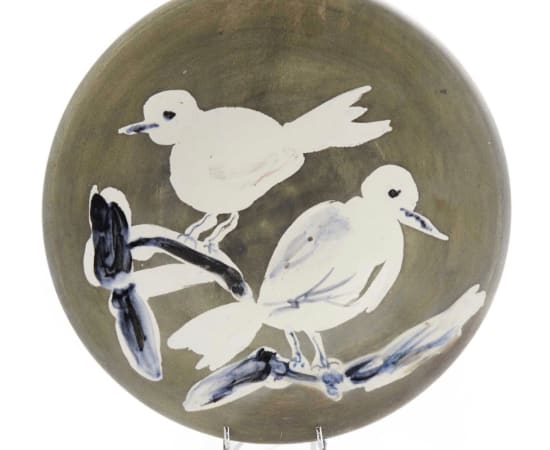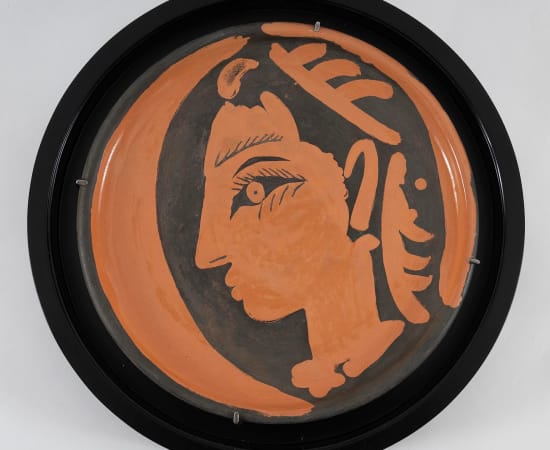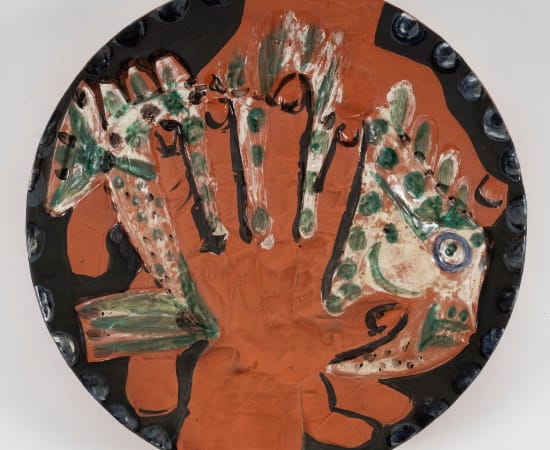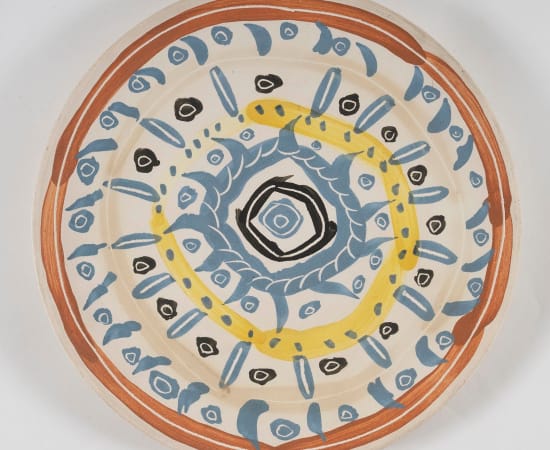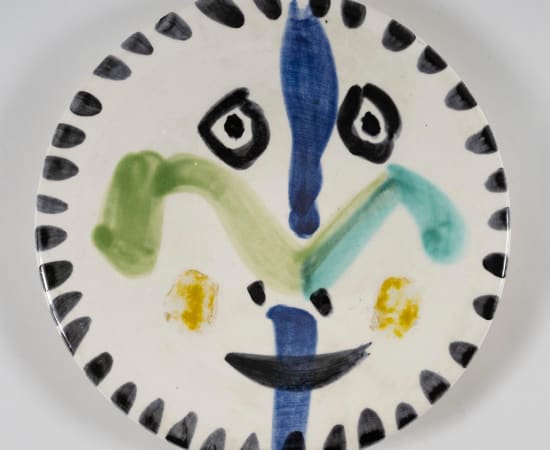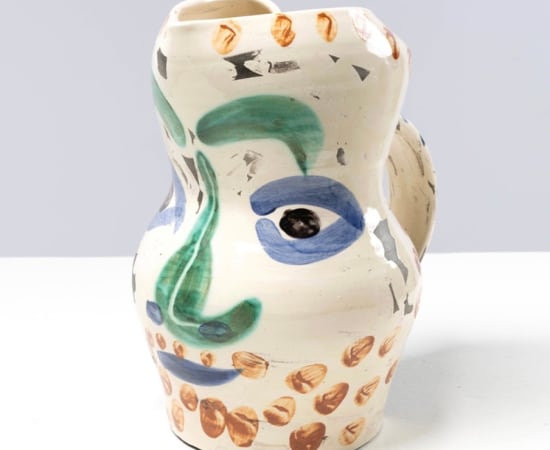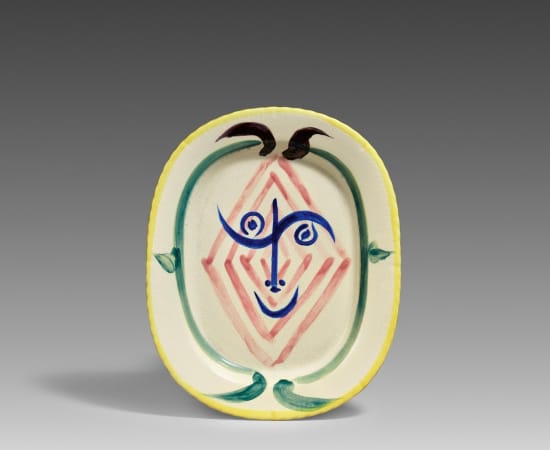Pablo Picasso (1881-1973) Spanish
Works
-
 Taureau et Picador (A.R. 369), 1956
Taureau et Picador (A.R. 369), 1956 -
 Pichet Poule (A.R. 250), 1954
Pichet Poule (A.R. 250), 1954 -
 Visage dans un ovale (A.R. 275), April 8th, 1955
Visage dans un ovale (A.R. 275), April 8th, 1955 -
 Musicien et danseur, 28.02.1957
Musicien et danseur, 28.02.1957 -
 Nature morte à la pomme
Nature morte à la pomme -
 Petit masque central, May 16th, 1963
Petit masque central, May 16th, 1963 -
 Ebauche de visage et inscriptions
Ebauche de visage et inscriptions -
 Nature morte au couvert et à la pomme
Nature morte au couvert et à la pomme -
 Tête de faune avec tests de lustre rose
Tête de faune avec tests de lustre rose -
 Esquisse de tête de faune, 10.3.48
Esquisse de tête de faune, 10.3.48 -
 Coupe Picador (A.R. 176), 1952
Coupe Picador (A.R. 176), 1952 -
 Visage Solaire, 27.01.1956
Visage Solaire, 27.01.1956 -
 Tête de faune, 27.02.1961
Tête de faune, 27.02.1961 -
 Profil de Jacqueline (A.R. 309), 22.01.1956
Profil de Jacqueline (A.R. 309), 22.01.1956 -
 Picador et taureau (A.R. 195), September 25th, 1953
Picador et taureau (A.R. 195), September 25th, 1953 -
 Pichet tête carrée (A.R. 223), 1953
Pichet tête carrée (A.R. 223), 1953 -
 Picador (A.R. 211), 1953
Picador (A.R. 211), 1953 -
 Taureau (A.R. 177), c. 1952
Taureau (A.R. 177), c. 1952 -
 Tête solaire II, 27.01.1956
Tête solaire II, 27.01.1956 -
 Têtes de taureau, Motif de décoration (au verso), 14.05.1957
Têtes de taureau, Motif de décoration (au verso), 14.05.1957 -
 Danseurs (A.R. 388), 1956
Danseurs (A.R. 388), 1956 -
 Bouquet à la pomme (A.R. 305), January 22nd, 1956
Bouquet à la pomme (A.R. 305), January 22nd, 1956 -
 Visage (A.R. 290), 1955
Visage (A.R. 290), 1955 -
 Taureau gravé (A.R. 32), 1947
Taureau gravé (A.R. 32), 1947 -
 Visage à la grille (A.R. 352), 1956
Visage à la grille (A.R. 352), 1956 -
 Vallauris (A.R. 179), March 10th, 1953
Vallauris (A.R. 179), March 10th, 1953 -
 Visage no.202 (A.R. 495), 1963
Visage no.202 (A.R. 495), 1963 -
 Jean Ramié, Maréchal des Logis de Réserve, 1955
Jean Ramié, Maréchal des Logis de Réserve, 1955 -
 Faune aux marottes, 1.12.1956
Faune aux marottes, 1.12.1956 -
 Colombe à la lucarne (A.R. 78), 1949
Colombe à la lucarne (A.R. 78), 1949 -
 Picador et taureau (A.R. 194), 1953
Picador et taureau (A.R. 194), 1953 -
 Tête de faune, 08.08.1956
Tête de faune, 08.08.1956 -
 Tête de faune, 14.03.1961
Tête de faune, 14.03.1961 -
 Visage, 1957
Visage, 1957 -
 Taureau et toreador, 11.2.57
Taureau et toreador, 11.2.57 -
 Tête de faune, circa 1968
Tête de faune, circa 1968 -
 Taureau sous un arbre (A.R. 159), 1952
Taureau sous un arbre (A.R. 159), 1952 -
 Visage de faune tourmenté (A.R. 320), 1956
Visage de faune tourmenté (A.R. 320), 1956 -
 Picador (A.R. 289), 1955
Picador (A.R. 289), 1955 -
 Pichet têtes (A.R. 368), 1956
Pichet têtes (A.R. 368), 1956 -
 Scène de tauromachie (A.R. 393), 1957
Scène de tauromachie (A.R. 393), 1957 -
 Joueur de flûte (A.R. 127), 1951
Joueur de flûte (A.R. 127), 1951 -
 Pichet Gothique aux feuilles (A.R. 178), 1952
Pichet Gothique aux feuilles (A.R. 178), 1952 -
 Paysage (A.R. 204), December 8th, 1953
Paysage (A.R. 204), December 8th, 1953 -
 Hibou noir perché (A.R. 398), May 7th, 1957
Hibou noir perché (A.R. 398), May 7th, 1957 -
 Tête (A.R. 372), 1956
Tête (A.R. 372), 1956 -
 Pichet visage bleu (Face tankard) (A.R. 434), 1959
Pichet visage bleu (Face tankard) (A.R. 434), 1959 -
 Oiseau à la huppe (A.R. 173), 1952
Oiseau à la huppe (A.R. 173), 1952 -
 Combat de centaure et géant , 02.10.1947
Combat de centaure et géant , 02.10.1947 -
 Joueur de flûte et chèvre (A.R. 382), 1956
Joueur de flûte et chèvre (A.R. 382), 1956 -
 Petits visages no.57 (A.R. 468), 1963
Petits visages no.57 (A.R. 468), 1963 -
 Oiseau au ver (A.R. 172), 1952
Oiseau au ver (A.R. 172), 1952 -
 Corrida (A.R. 181), 11.03.1953
Corrida (A.R. 181), 11.03.1953 -
 Nature morte (A.R. 219), 1953
Nature morte (A.R. 219), 1953 -
 Toros (A.R. 161), July 29th, 1952
Toros (A.R. 161), July 29th, 1952 -
 Cavalier et cheval (A.R. 138), 1952
Cavalier et cheval (A.R. 138), 1952 -
 Visage noir moucheté (A.R. 49), 1948
Visage noir moucheté (A.R. 49), 1948 -
 Tête de femme couronnée de fleurs (A.R. 236), March 20th, 1954
Tête de femme couronnée de fleurs (A.R. 236), March 20th, 1954 -
 Figure féminine, 1951
Figure féminine, 1951 -
 Tête faune
Tête faune -
 Buste de faune
Buste de faune -
 Petit faune, circa 1957
Petit faune, circa 1957 -
 Petite chouette (variante) (A.R. 82), 1949
Petite chouette (variante) (A.R. 82), 1949 -
 Pichet têtes (A.R. 367), 1956
Pichet têtes (A.R. 367), 1956 -
 Pichet tête (A.R. 221), 1953
Pichet tête (A.R. 221), 1953 -
 Joueur de flûte (A.R. 127), 1951
Joueur de flûte (A.R. 127), 1951 -
 Cruchon Hibou (A.R. 293), 1955
Cruchon Hibou (A.R. 293), 1955 -
 Picador (A.R. 160), 1952
Picador (A.R. 160), 1952 -
 Face (A.R. 288), 1955
Face (A.R. 288), 1955 -
 Oiseau (A.R. 260), 31.03.1955
Oiseau (A.R. 260), 31.03.1955 -
 Oiseau sur la branche (A.R. 175), 1952
Oiseau sur la branche (A.R. 175), 1952 -
 Visage de Faune (A.R. 283), June 28th, 1955
Visage de Faune (A.R. 283), June 28th, 1955 -
 Picador (A.R. 201), September 25th, 1953
Picador (A.R. 201), September 25th, 1953 -
 Profil de Jacqueline (A.R. 383), 1956
Profil de Jacqueline (A.R. 383), 1956 -
 Visage, 1956
Visage, 1956 -
 Pichet Picador (A.R. 162), September 5th, .1952
Pichet Picador (A.R. 162), September 5th, .1952 -
 Yan visage (A.R. 512), 1963
Yan visage (A.R. 512), 1963 -
 Pichet Visage (A.R. 611), January 1st, 1969
Pichet Visage (A.R. 611), January 1st, 1969 -
 Corrida (A.R. 182), March 11th, 1953
Corrida (A.R. 182), March 11th, 1953 -
 Scène de Tauromachie (A.R. 412), June 11th, 1959
Scène de Tauromachie (A.R. 412), June 11th, 1959 -
 Cavalier et cheval (A.R. 137), 1952
Cavalier et cheval (A.R. 137), 1952 -
 Pêcheur (A.R. 262), 1955
Pêcheur (A.R. 262), 1955 -
 Chouette femme (A.R. 119), 1951
Chouette femme (A.R. 119), 1951 -
 Profil de femme no.67 (A.R. 473), 1963
Profil de femme no.67 (A.R. 473), 1963 -
 Taureau dans l'arène (A.R. 80), 1948
Taureau dans l'arène (A.R. 80), 1948 -
 Vase au bouquet (A.R. 304), January 22nd, 1956
Vase au bouquet (A.R. 304), January 22nd, 1956 -
 Poule, Lustre Brun 46, 1946
Poule, Lustre Brun 46, 1946 -
 Visage no.0 (A.R. 458), 1963
Visage no.0 (A.R. 458), 1963 -
 Médaillon tête géométrique, 1956
Médaillon tête géométrique, 1956 -
 Visage no.111 (A.R. 476), 1963
Visage no.111 (A.R. 476), 1963 -
 Picador et taureau (A.R. 438), 1959
Picador et taureau (A.R. 438), 1959 -
 Visage aux cheveux bouclés (A.R. 574), December 1968
Visage aux cheveux bouclés (A.R. 574), December 1968 -
 Cruche aux oiseaux (A.R. 456), 1962
Cruche aux oiseaux (A.R. 456), 1962 -
 Pichet au vase (A.R. 226), January 12th, 1954
Pichet au vase (A.R. 226), January 12th, 1954 -
 La veilleuse, June 18th, 1957
La veilleuse, June 18th, 1957 -
 Visage et Hibou (A.R. 407), 1958
Visage et Hibou (A.R. 407), 1958 -
 Joueur de diaule (A.R. 1), 1947
Joueur de diaule (A.R. 1), 1947 -
 Visage no.0 (A.R. 458), 1963
Visage no.0 (A.R. 458), 1963 -
 Visage no.197 (A.R. 494), 1963
Visage no.197 (A.R. 494), 1963 -
 Visage no.130 (A.R. 479), 1963
Visage no.130 (A.R. 479), 1963 -
 Visage (A.R. 448), 1960
Visage (A.R. 448), 1960 -
 Chouette (A.R. 603), 1969
Chouette (A.R. 603), 1969 -
 Pour les Ramié, December 25th, 1966
Pour les Ramié, December 25th, 1966 -
 Trois poissons sur fond gris (A.R. 396), April 11th, 1957
Trois poissons sur fond gris (A.R. 396), April 11th, 1957 -
 Tête de chèvre de profil (A.R. 109), 1950
Tête de chèvre de profil (A.R. 109), 1950 -
 Poisson chiné (A.R. 170), 1952
Poisson chiné (A.R. 170), 1952 -
 Tête de chèvre de profil (A.R. 145), June 5th, 1952
Tête de chèvre de profil (A.R. 145), June 5th, 1952 -
 Colombe de la Paix, June 7th, 1954
Colombe de la Paix, June 7th, 1954 -
 Corrida soleil (A.R. 199), September 25th, 1953
Corrida soleil (A.R. 199), September 25th, 1953 -
 Deux oiseaux no.95 (A.R. 487), 1963
Deux oiseaux no.95 (A.R. 487), 1963 -
 Visage géométrique (A.R. 357), 1956
Visage géométrique (A.R. 357), 1956 -
 Profil de Jacqueline (A.R. 457), 1962
Profil de Jacqueline (A.R. 457), 1962 -
 Mains au poisson (A.R. 214), 1953
Mains au poisson (A.R. 214), 1953 -
 Motifs no.7 (A.R. 459), 1963
Motifs no.7 (A.R. 459), 1963 -
 Motif spiralé (A.R. 404), 1957
Motif spiralé (A.R. 404), 1957 -
 Tapis, circa 1928-1929 I After the painting "Pipe" (1918)
Tapis, circa 1928-1929 I After the painting "Pipe" (1918) -
 Visage no.144 (A.R. 480), 1963
Visage no.144 (A.R. 480), 1963 -
 Visage de femme (A.R. 220), 1953
Visage de femme (A.R. 220), 1953 -
 Visage aux points (A.R. 610), 1969
Visage aux points (A.R. 610), 1969 -
 Tête de faune (A.R. 51), 1948
Tête de faune (A.R. 51), 1948 -
 Chouette aux plumes (A.R. 122), 1951
Chouette aux plumes (A.R. 122), 1951
Video
Biography
Pablo Picasso (1881–1973) remains one of the most celebrated and influential artists of the 20th century. A visionary painter, sculptor, and multidisciplinary creator, Picasso continuously redefined artistic expression, pioneering movements such as Cubism and revolutionizing modern art. His relentless innovation, mastery of form, and ability to transcend artistic boundaries make his work a cornerstone of the Bailly Gallery collection.
Born in Málaga, Spain, Picasso demonstrated prodigious talent from an early age, studying at prestigious art schools in Barcelona and Madrid. His early works evolved through distinct artistic phases, including the deeply emotive Blue Period (1901–1904) and the poetic Rose Period (1904–1906). In 1907, he created Les Demoiselles d'Avignon, a radical departure from traditional representation that laid the foundation for Cubism, a movement he developed alongside Georges Braque. This new visual language, characterized by fragmented forms and multiple perspectives, reshaped modern art forever.
Picasso’s influence extended far beyond Cubism. He experimented with Surrealism, Neoclassicism, and Expressionism, producing iconic works such as Guernica (1937), a powerful anti-war statement that remains one of the most significant political paintings in history. Over his prolific career, he created an extraordinary body of work, spanning painting, sculpture, ceramics, and printmaking, with over 50,000 recorded pieces.
At Bailly Gallery, we celebrate Picasso’s unparalleled contribution to modern art. His ability to challenge artistic conventions and continuously reinvent his style ensures that his legacy remains as relevant today as ever.
Born in Málaga, Spain, Picasso demonstrated prodigious talent from an early age, studying at prestigious art schools in Barcelona and Madrid. His early works evolved through distinct artistic phases, including the deeply emotive Blue Period (1901–1904) and the poetic Rose Period (1904–1906). In 1907, he created Les Demoiselles d'Avignon, a radical departure from traditional representation that laid the foundation for Cubism, a movement he developed alongside Georges Braque. This new visual language, characterized by fragmented forms and multiple perspectives, reshaped modern art forever.
Picasso’s influence extended far beyond Cubism. He experimented with Surrealism, Neoclassicism, and Expressionism, producing iconic works such as Guernica (1937), a powerful anti-war statement that remains one of the most significant political paintings in history. Over his prolific career, he created an extraordinary body of work, spanning painting, sculpture, ceramics, and printmaking, with over 50,000 recorded pieces.
At Bailly Gallery, we celebrate Picasso’s unparalleled contribution to modern art. His ability to challenge artistic conventions and continuously reinvent his style ensures that his legacy remains as relevant today as ever.
Enquire
